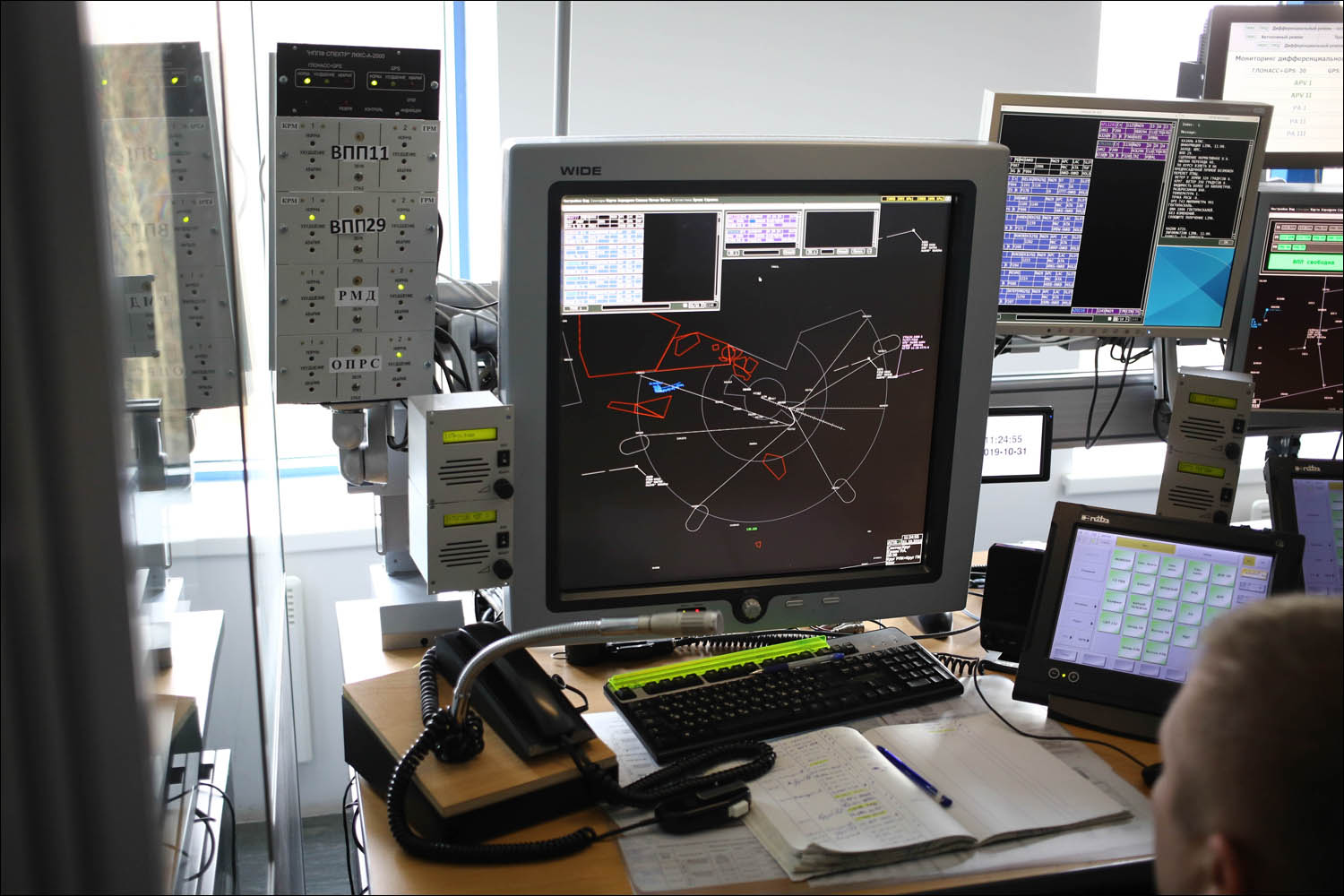 The workplace of the circle dispatcher, in front there is a microphone for communication with crews and ground services, on the left is the control of the course-glide path system.
The workplace of the circle dispatcher, in front there is a microphone for communication with crews and ground services, on the left is the control of the course-glide path system.Now we will go through those places that passengers usually do not see, and where they are usually not allowed to shoot. Below is where the planes come from at the airport. More precisely, what is needed is for them to get to the terminal.
Traffic service of the Kazan ATS center of the Tataeronavigatsiya branch of FSUE State ATM Corporation
First, we go to the DPP - the control center of the approach. Each control room serves aircraft in its area of responsibility (for example, taxiing, launch, lap, and so on). And airport services are on the ground. When the doors close and the gangway leaves, the flight technically begins, and the crew passes under the control of the taxi control station. The DPR transmits the taxi route and the conditions of the initial phase of the flight before entering the airway.
Before occupying the strip (runway), the crew switches to communication with the SDP manager, who already checks if the strip is free. And is there anyone who comes in to land? If everything is in order, permission is given to occupy the runway. The crew reports the readiness, the dispatcher allows takeoff.
 Here are the jobs: the local control center serving the movement of small aircraft in the Republic of Tatarstan
Here are the jobs: the local control center serving the movement of small aircraft in the Republic of TatarstanAs they climb, the crew contacts the KDP and the DPS (circle and approach), which direct the aircraft to the airway. When the plane leaves the runway area, the dispatcher transfers the vessel to the next adjacent control center. And so, before arriving at the destination aerodrome: from one dispatcher to another before boarding and parking. Stopped, turned off the engine? Transmitted to airport services.
Naturally, there is a constant exchange of information with both airport services and other traffic management services. Each event has its own chain of updates. In the analogies of the IT world, we observe the exchange of data via the bus. The channel is not very important, the protocol (that is, the regulation) and the clarity of the procedures are important. In Soviet times there was a radio bureau with a telegraph and corresponding delays. It was more difficult to work, but they managed to do everything, and there was more movement. Airport Kazan during busy periods served 180 sorties (that is, approximately 360 take-offs and landings per day), and now about 100-120 flights per day. But I must say that then there were a lot of small aircraft.
 Dispatch Approach
Dispatch Approach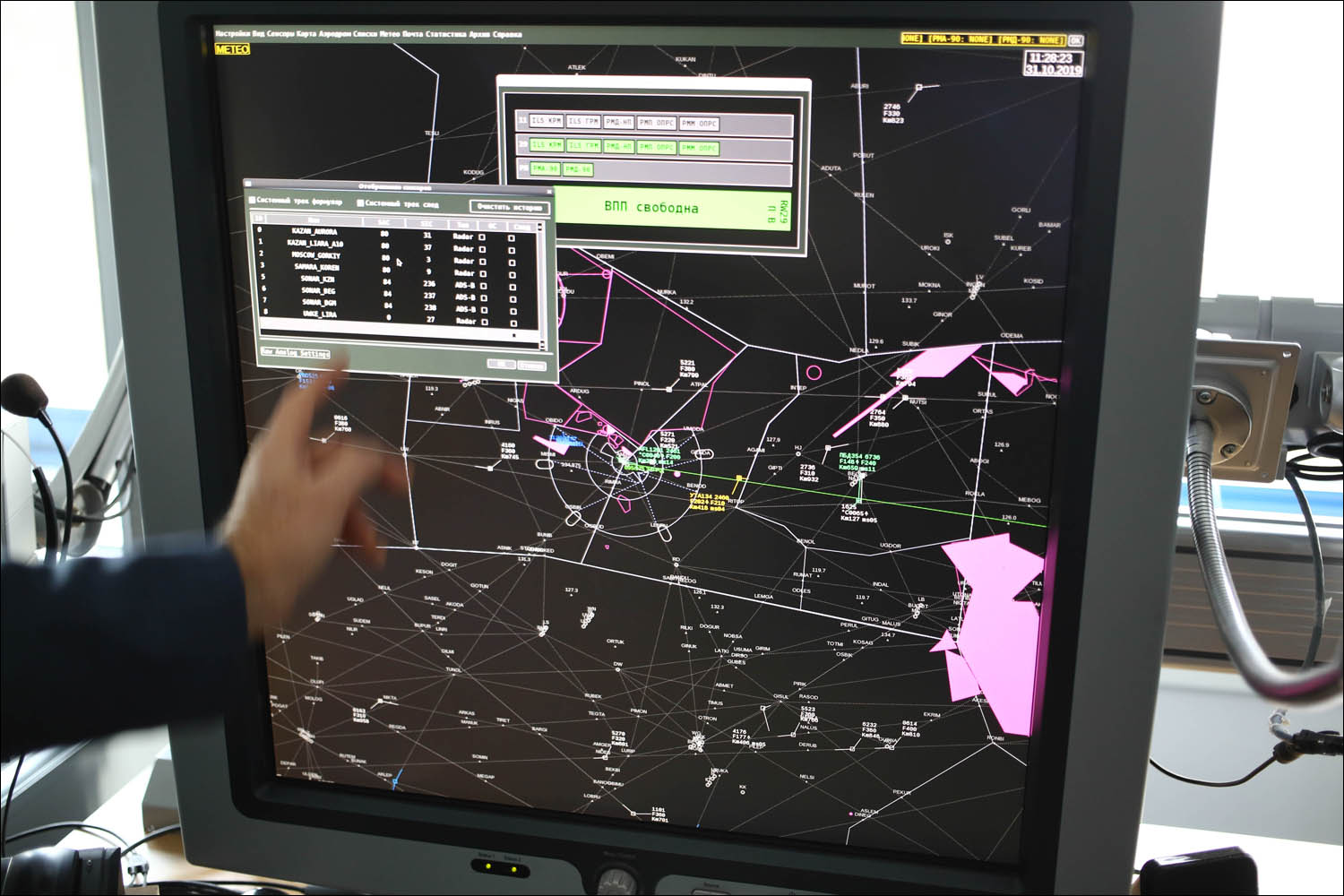
For the airport, the basis is a schedule of aircraft traffic. Further, there are approved flight plans for specific flights. Further, all airport services should try to keep fit so that refueling, boarding passengers, service and everything else was done on time - that is, at the time of departure. Because it is necessary to take off according to the schedule, and if the plane arrived on time, but has not yet been refueled, there is a flaw in one of the airport services.
Here's a
post about how takeoff looks from a pilot’s perspective.
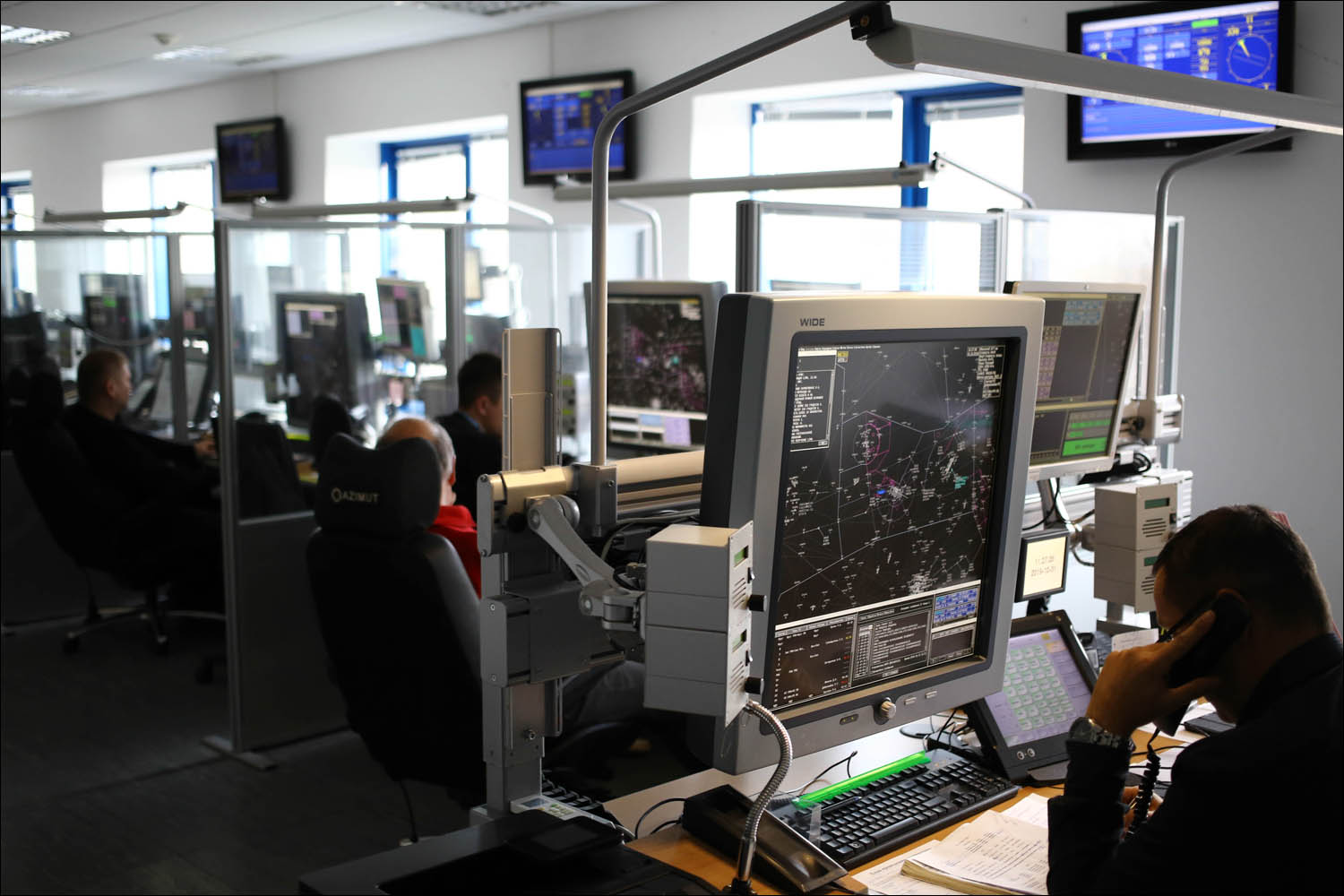 Well, here is the flight director’s position
Well, here is the flight director’s positionKazan on the map is located exactly on several very busy routes (including from Asia to Moscow), so more than 500 flights a day go through the airspace of the Kazan ATS center. Situations when passengers need medical care happen quite often. The aircraft commander makes a decision and reports this to the dispatcher. Usually, an approach pattern is determined and airport services are informed - so that the medical service waits on the spot and so that an ambulance is called from the city.
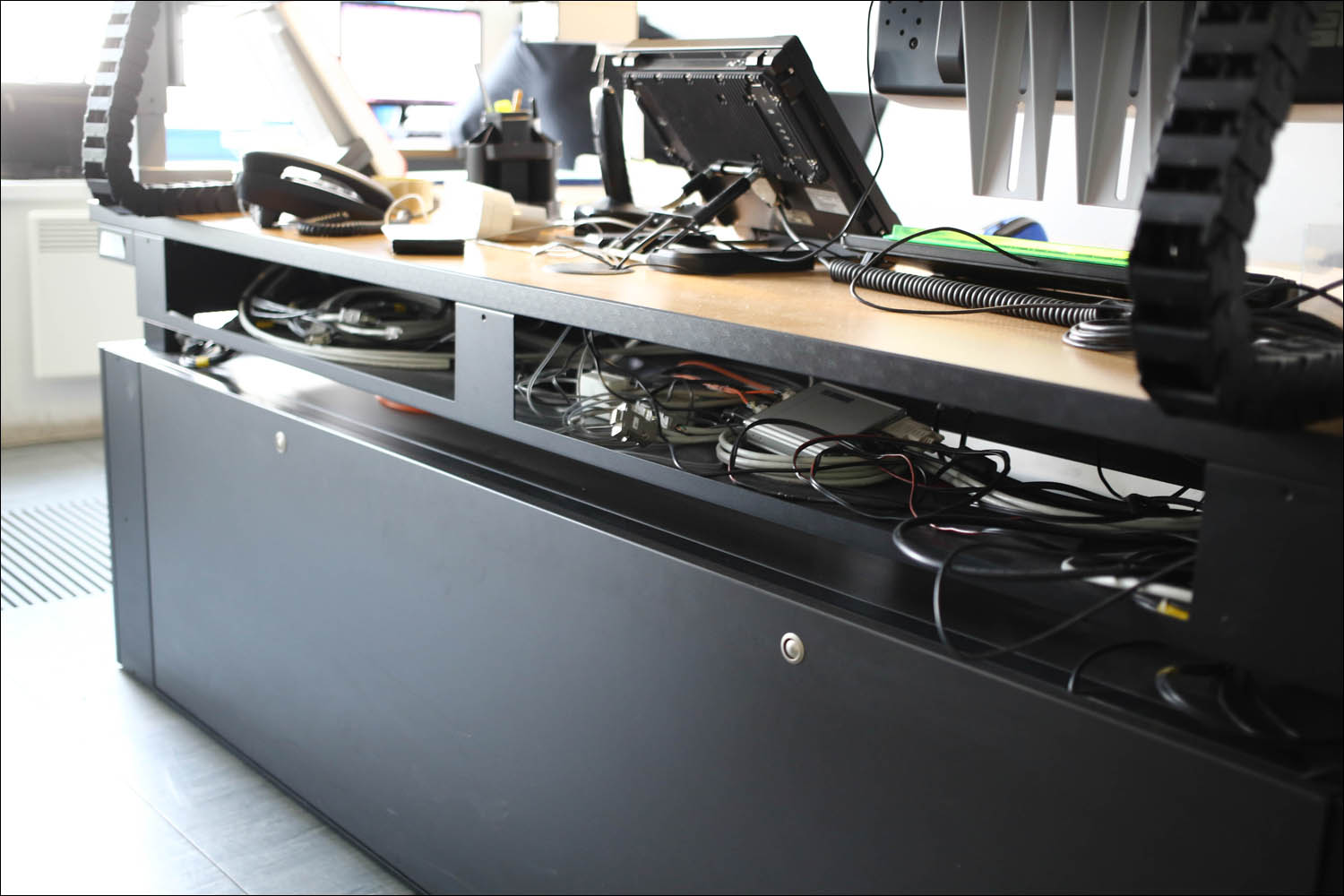 Lots of spare cables
Lots of spare cables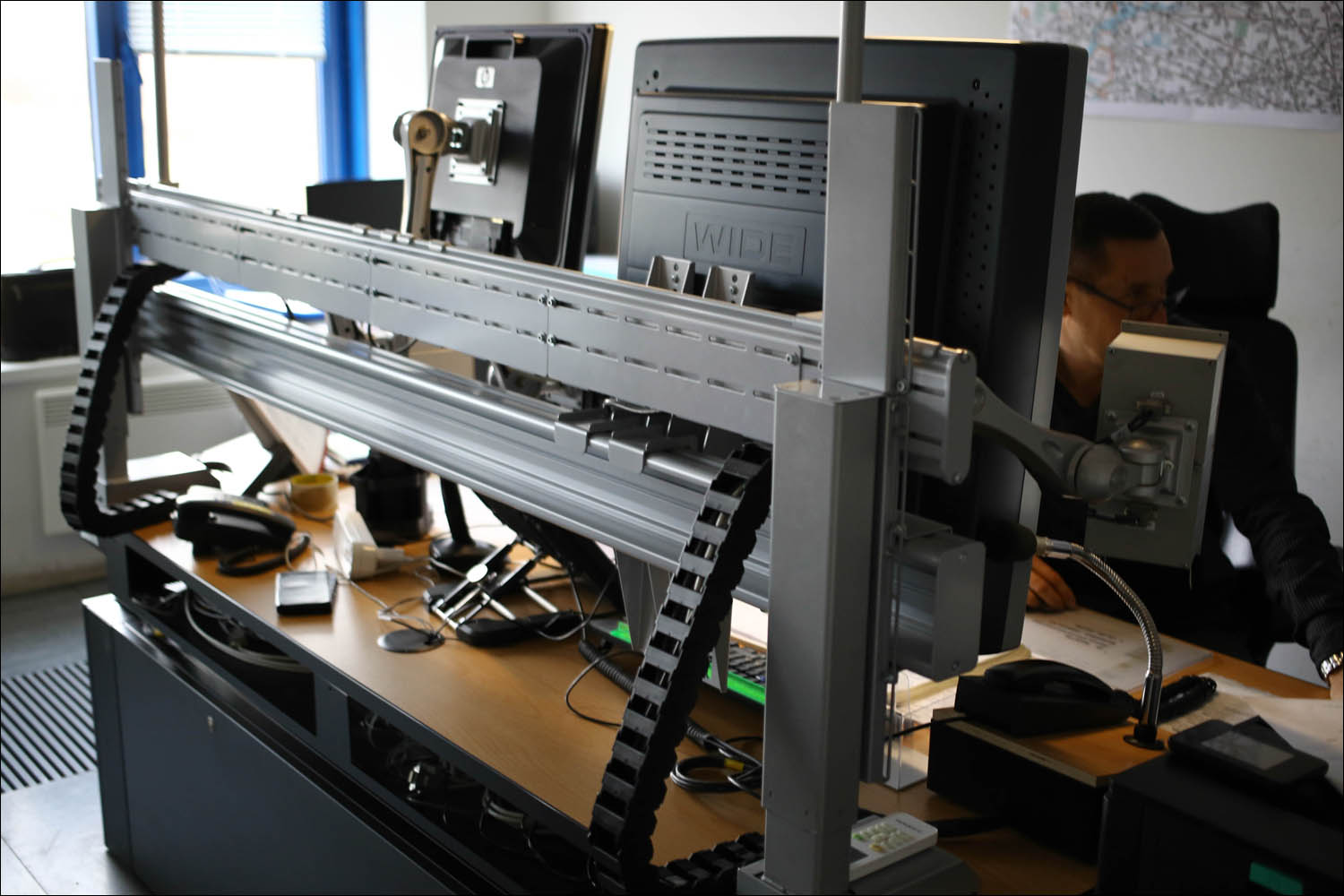 Monumental consoles for mounting monitors
Monumental consoles for mounting monitorsYou can read more about the work of a dispatcher directly controlling air traffic in posts about
how air traffic works and
about the work of a dispatcher .
Trained in the profession of air traffic controller at St. Petersburg State University of Civil Aviation and the Ulyanovsk Institute of Civil Aviation. Graduates who came to work in the Tataeronavigatsiya branch undergo an internship that includes simulator training. The simulator is the same workplace as a regular one, only on the monitor the dispatcher does not have real data from real sources, but training situations. At first it’s quite simple, and then it all turns in complexity into the “Ender Game”.
Radio engineers
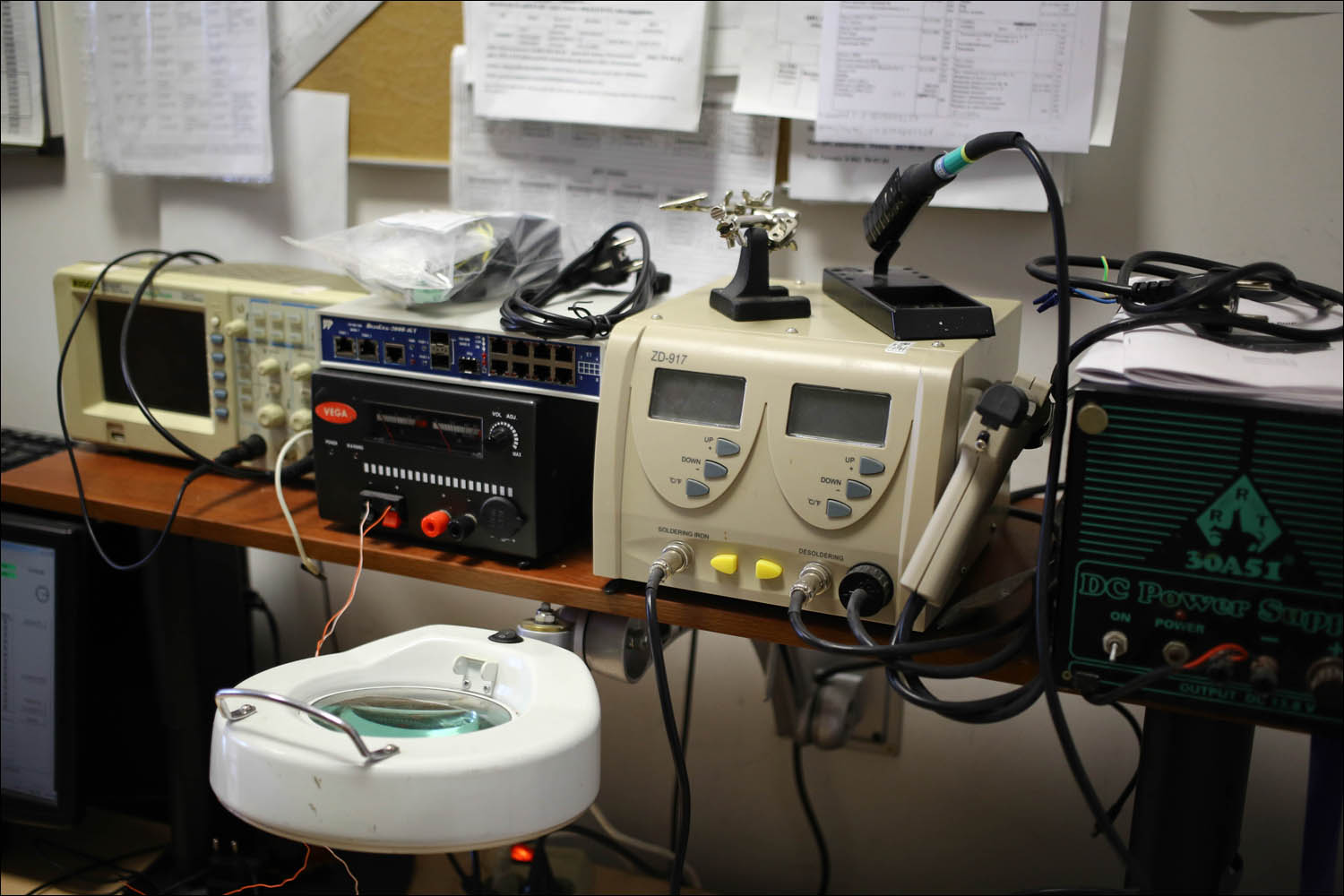
All radio equipment needs engineers. It is these people who know exactly what can be approached on the airfield, and what should not be allowed even for spotters. It is these people who laugh every time they watch a video like this:
In short - the beam from the aircraft’s locator just slides over you, and there’s nothing serious, the lighthouse is far away (it is usually at the far end of the strip, the second in the middle), and ground-based locators scramble up.There is a lot of equipment, the first in Russia complex
KSA ATC "Galaxy" was delivered to the Universiade.
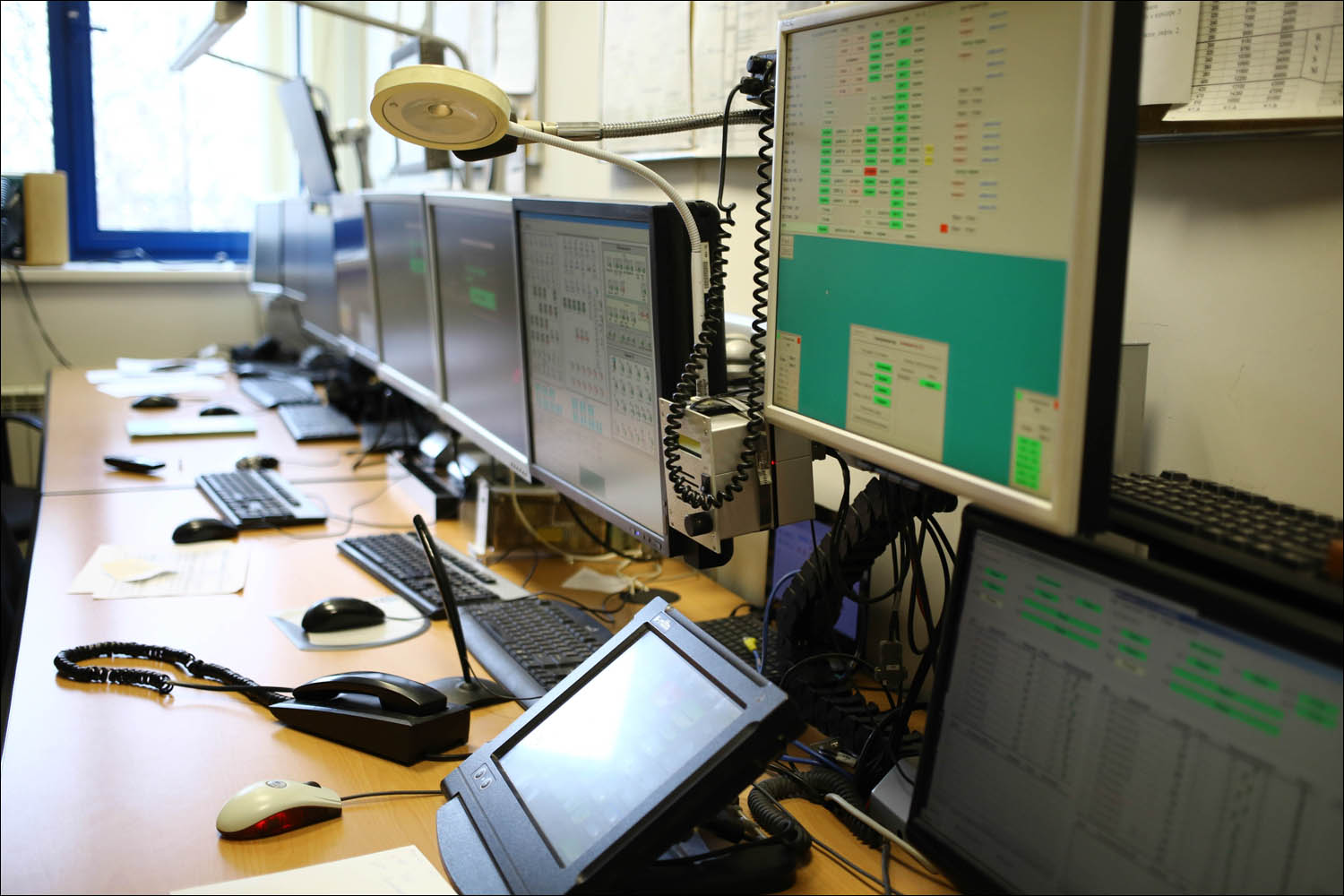

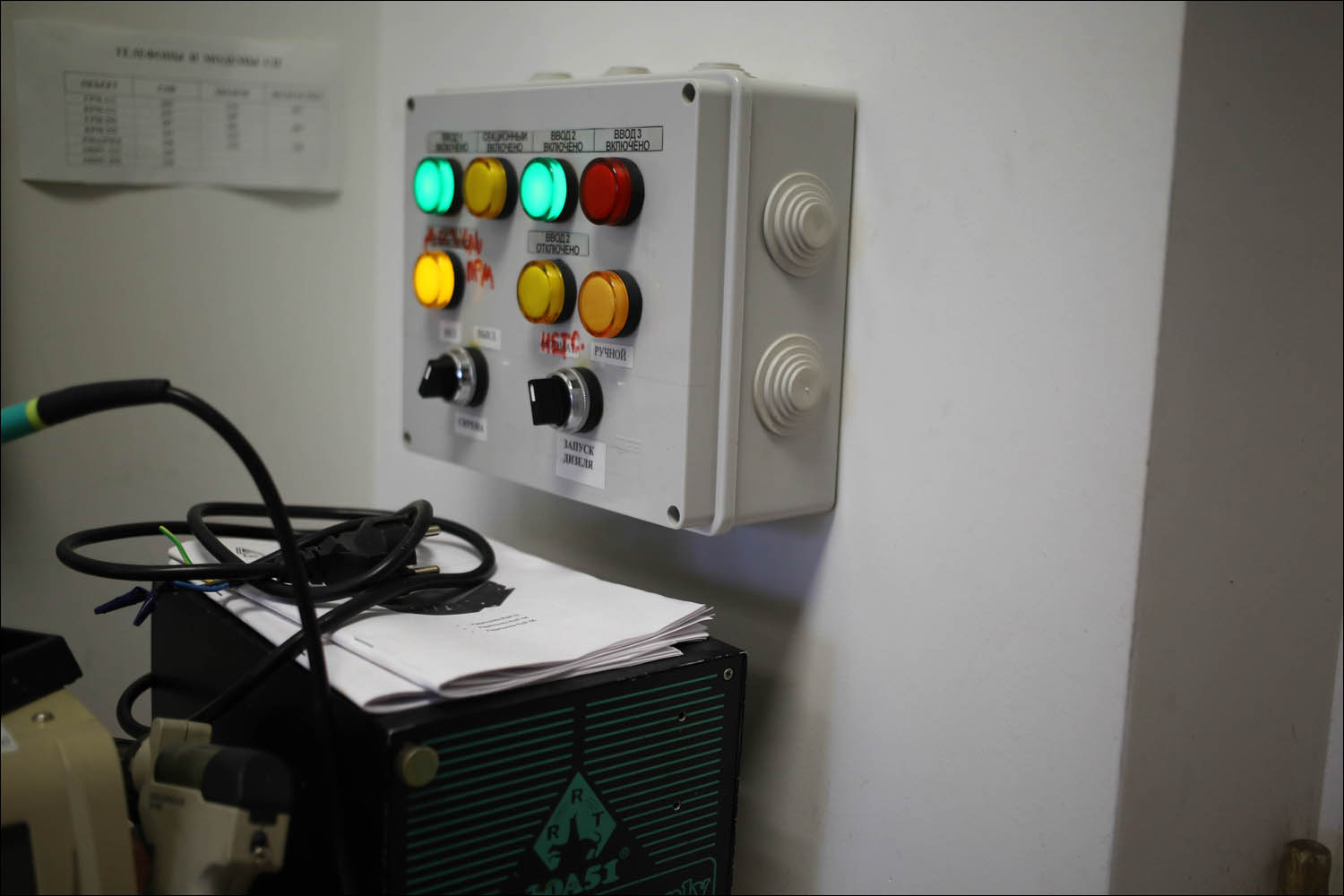
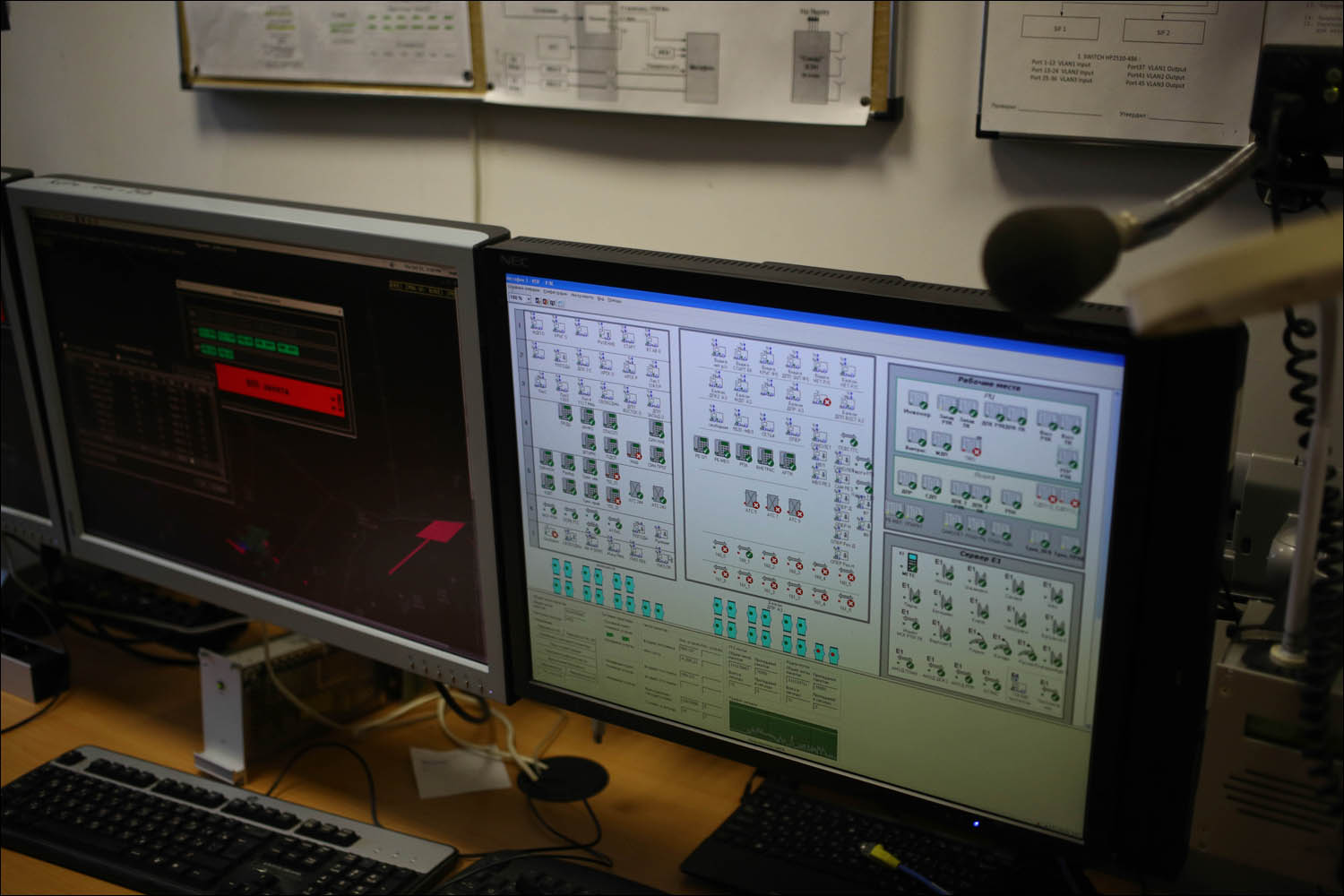
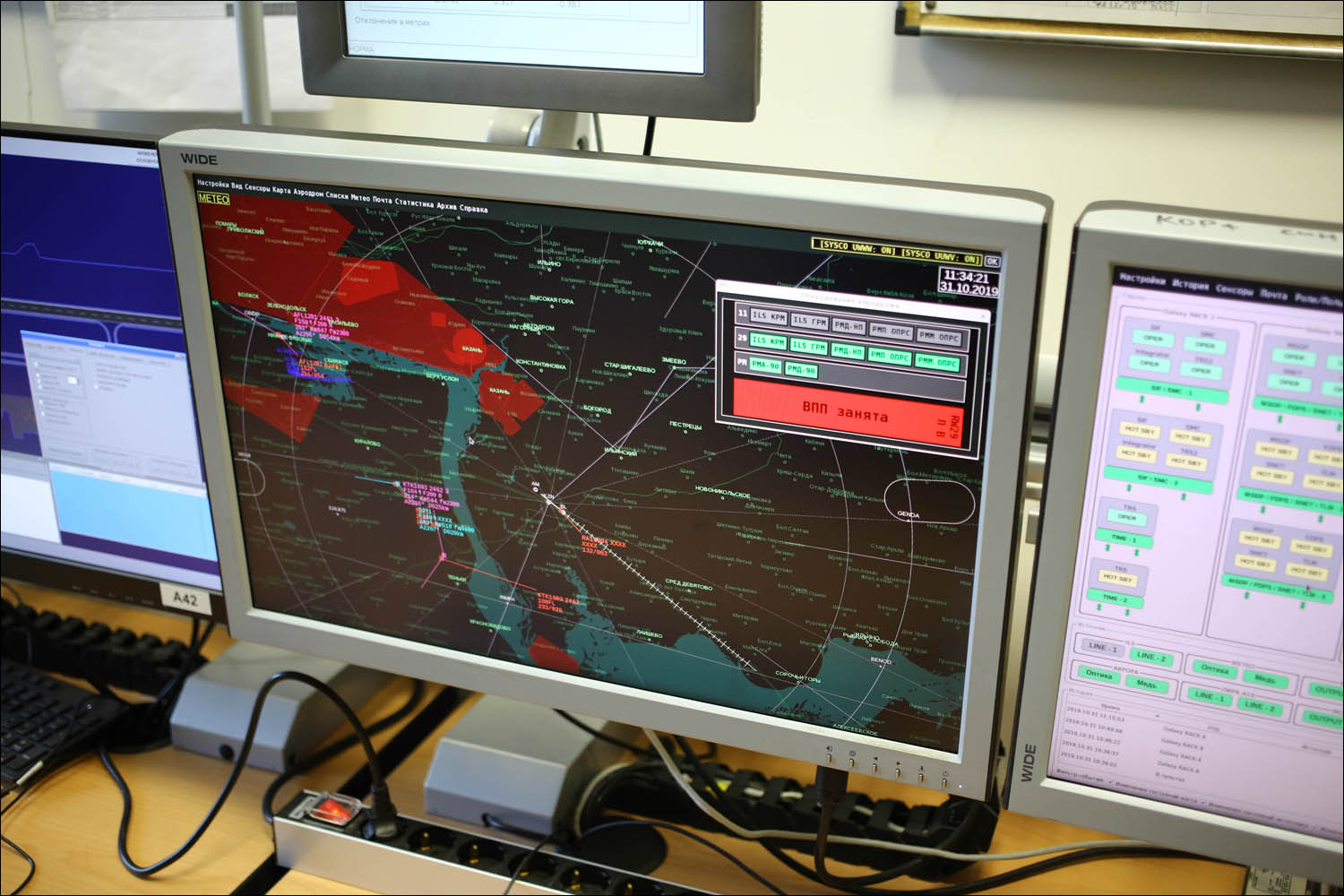
The system integrates with
Vega - that is, it can be used as a data source to determine the position of an aircraft on an airfield.
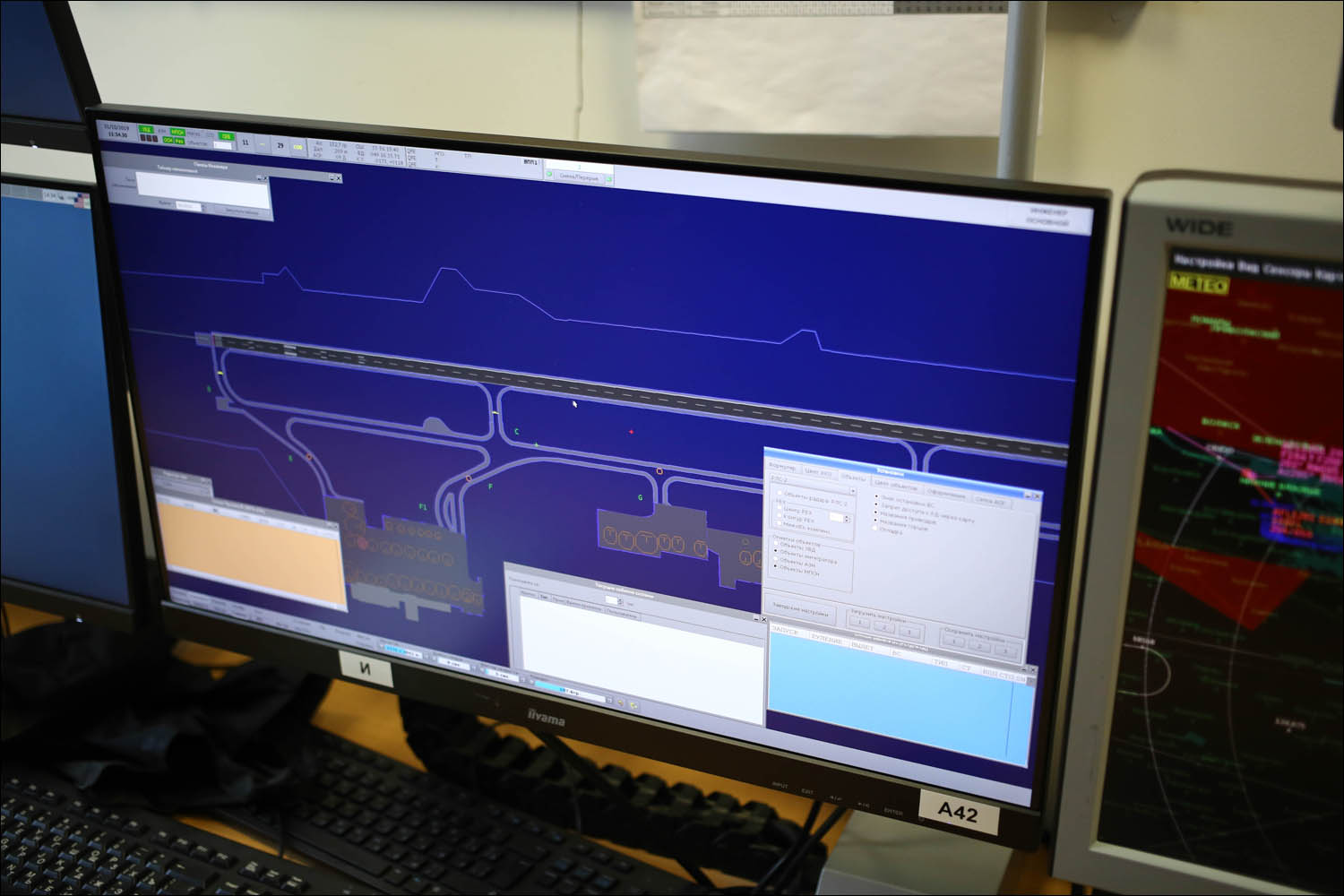
And here are the very people who monitor all operations in the air. In particular, among other things, a drone with all permissions is operating near Kazan.
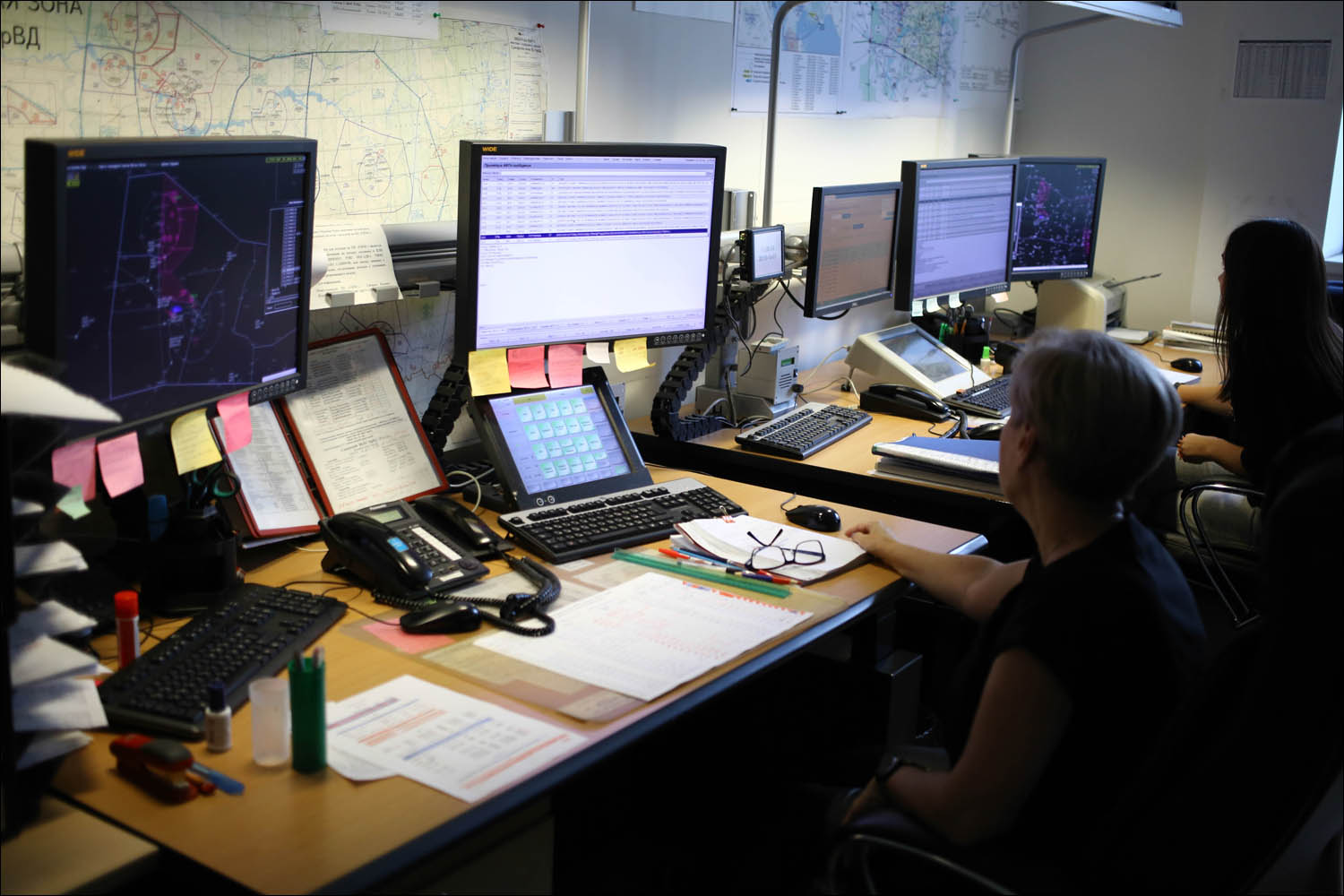
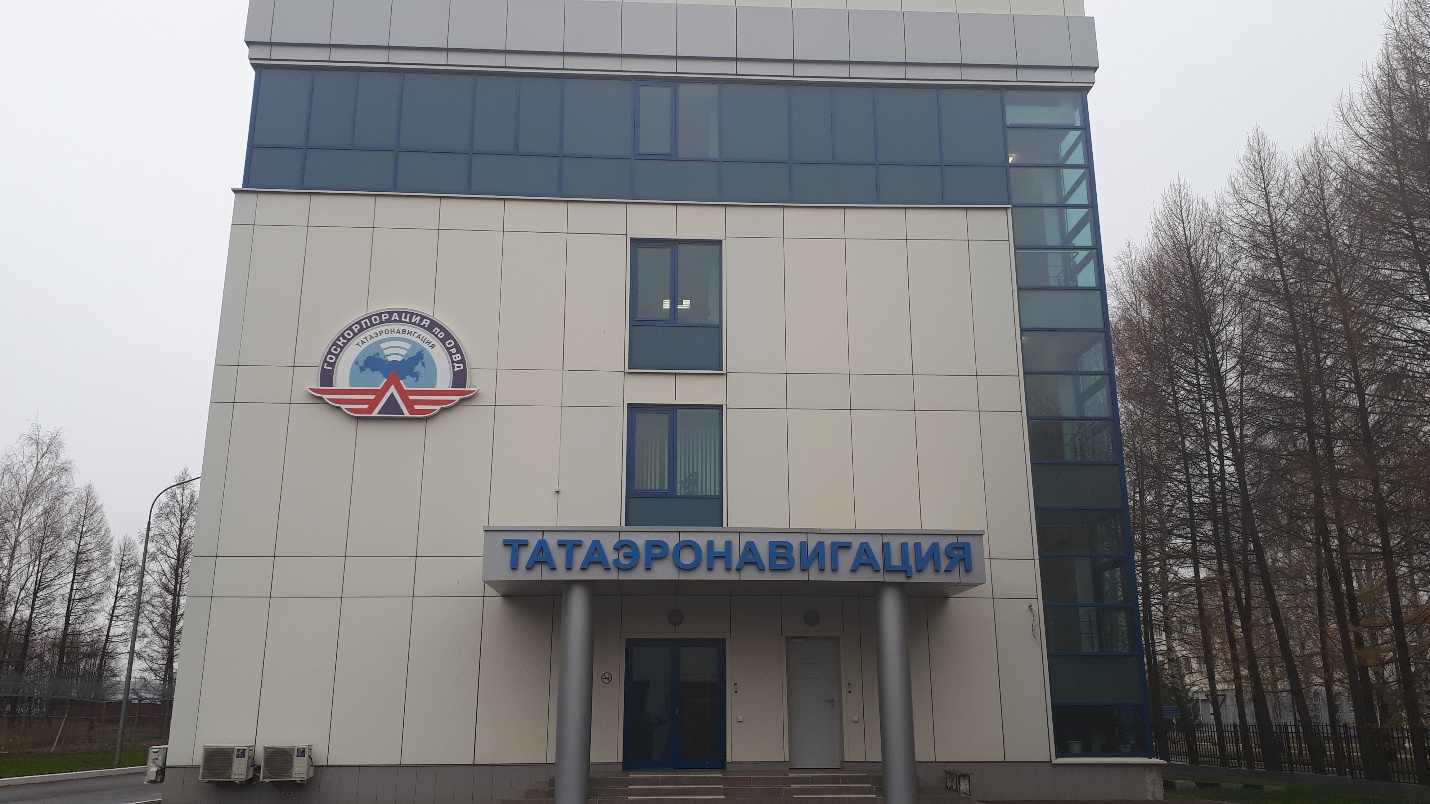
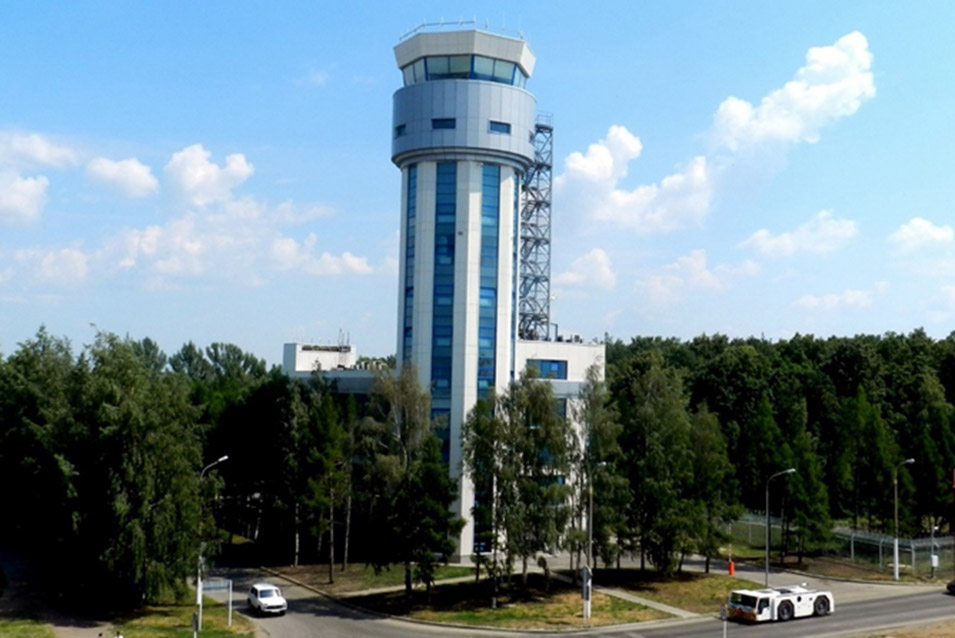 Buildings of the traffic control center of the Kazan ATS center of the Tataeronavigatsiya branch of FSUE State ATM Corporation, photographs from the archive of the state corporation
Buildings of the traffic control center of the Kazan ATS center of the Tataeronavigatsiya branch of FSUE State ATM Corporation, photographs from the archive of the state corporationNow go to the tower
Workplaces:
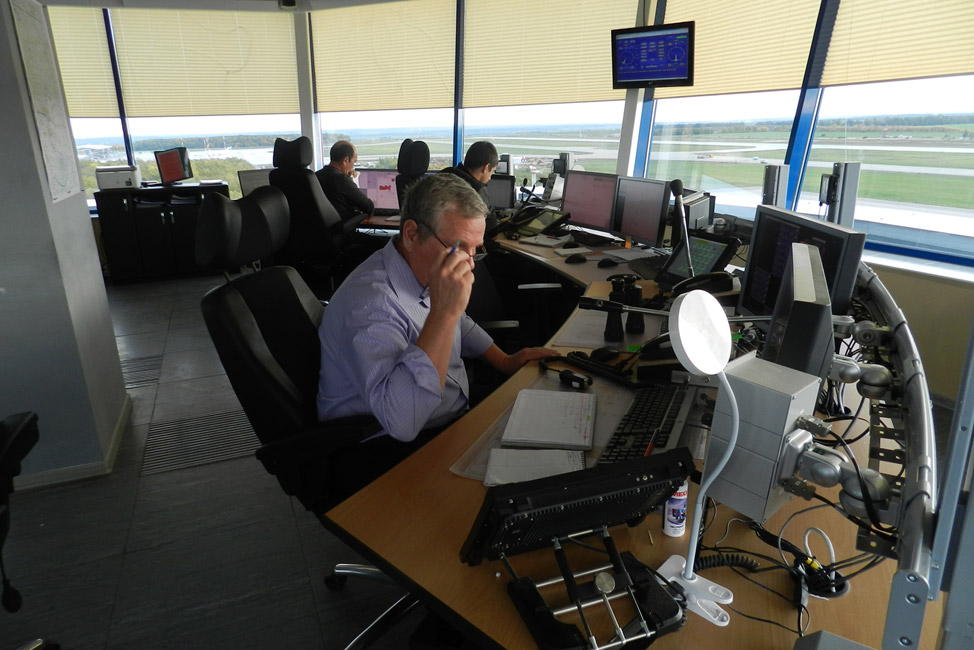
From far to near - taxiing, start.
The flight director of the airdrome sits separately:
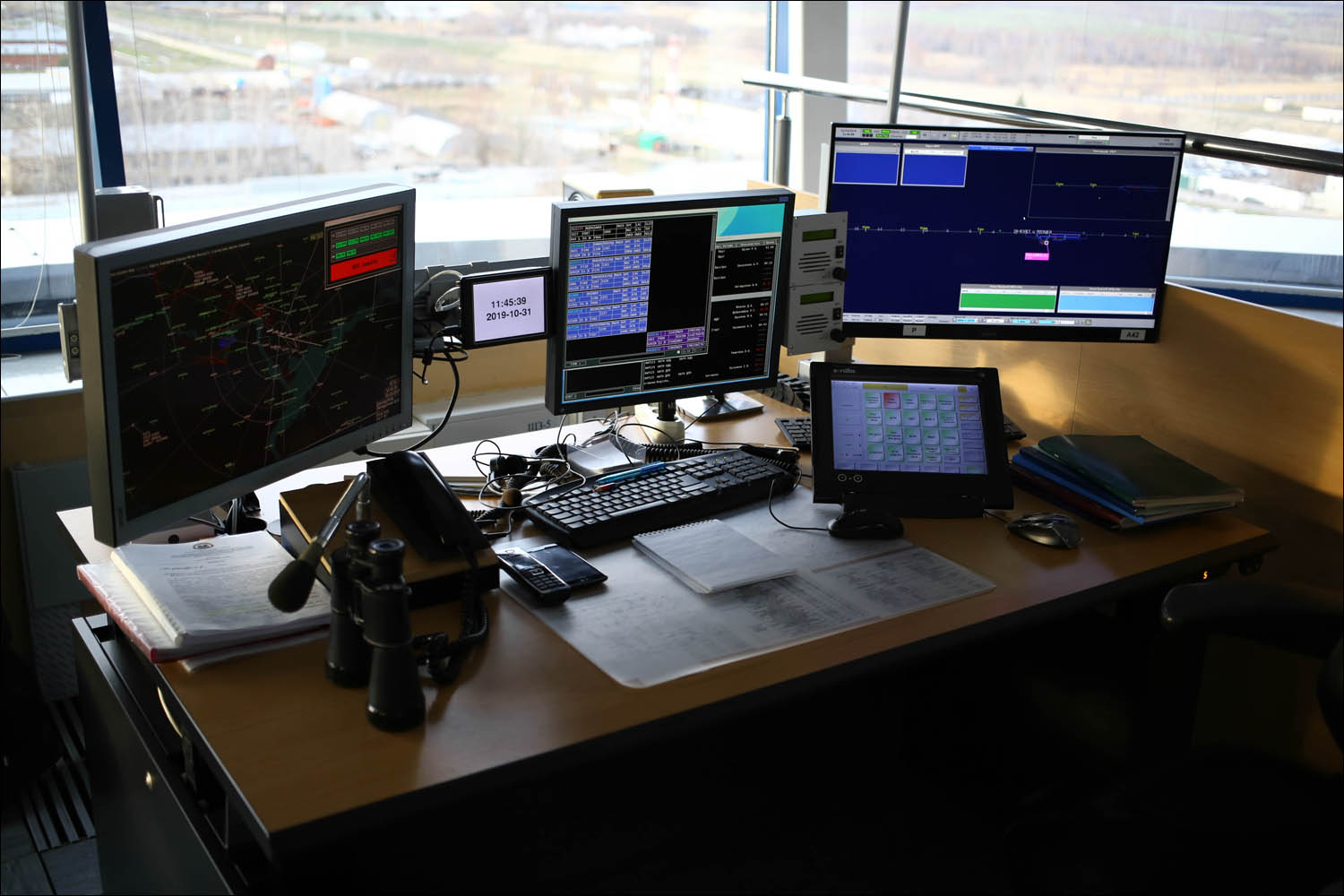
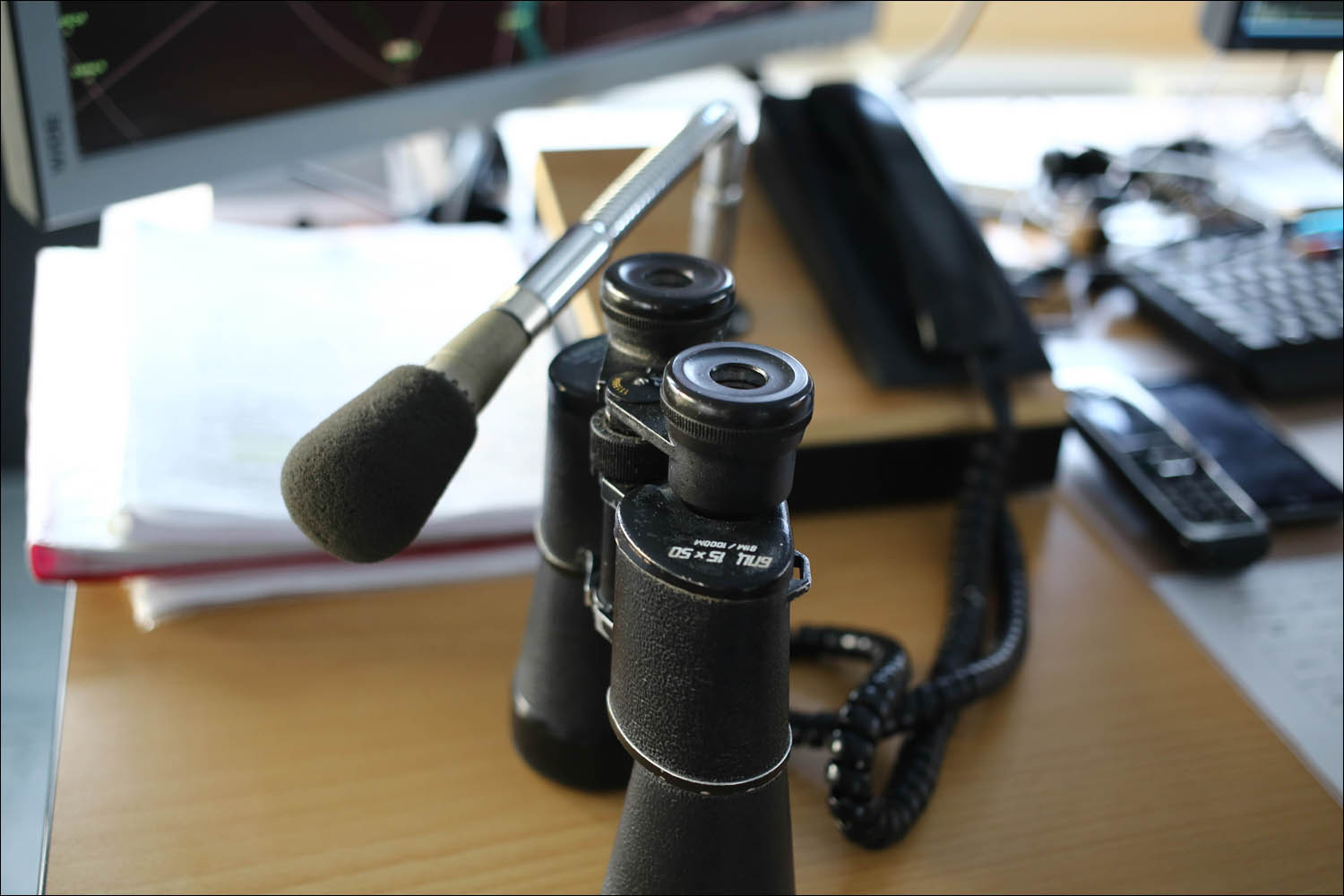
Here comes the new shift:
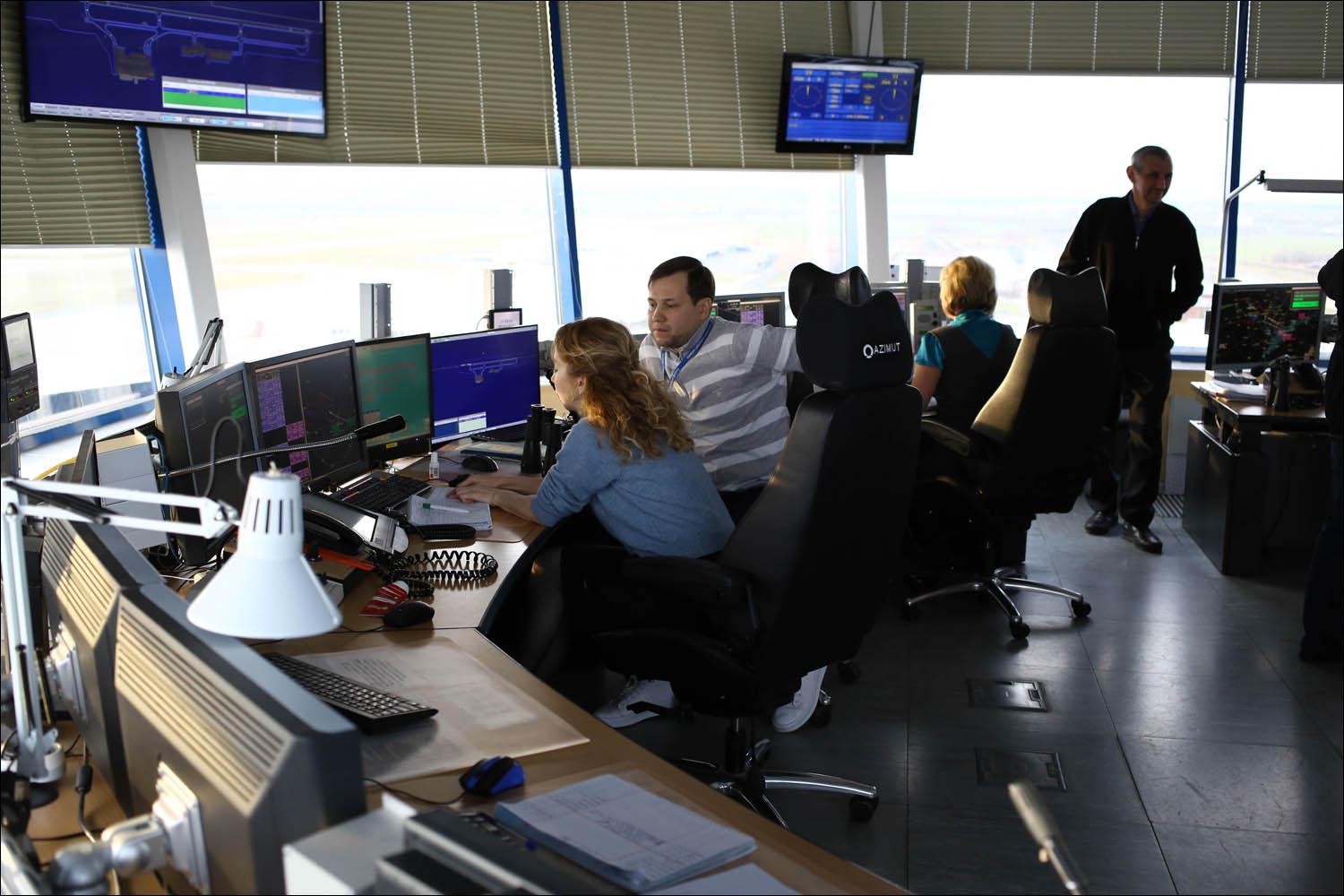 “Two landing flights here and there, electricians are working near the parking lot, do not bother them, send them to the others, in general, that's all.”
“Two landing flights here and there, electricians are working near the parking lot, do not bother them, send them to the others, in general, that's all.”
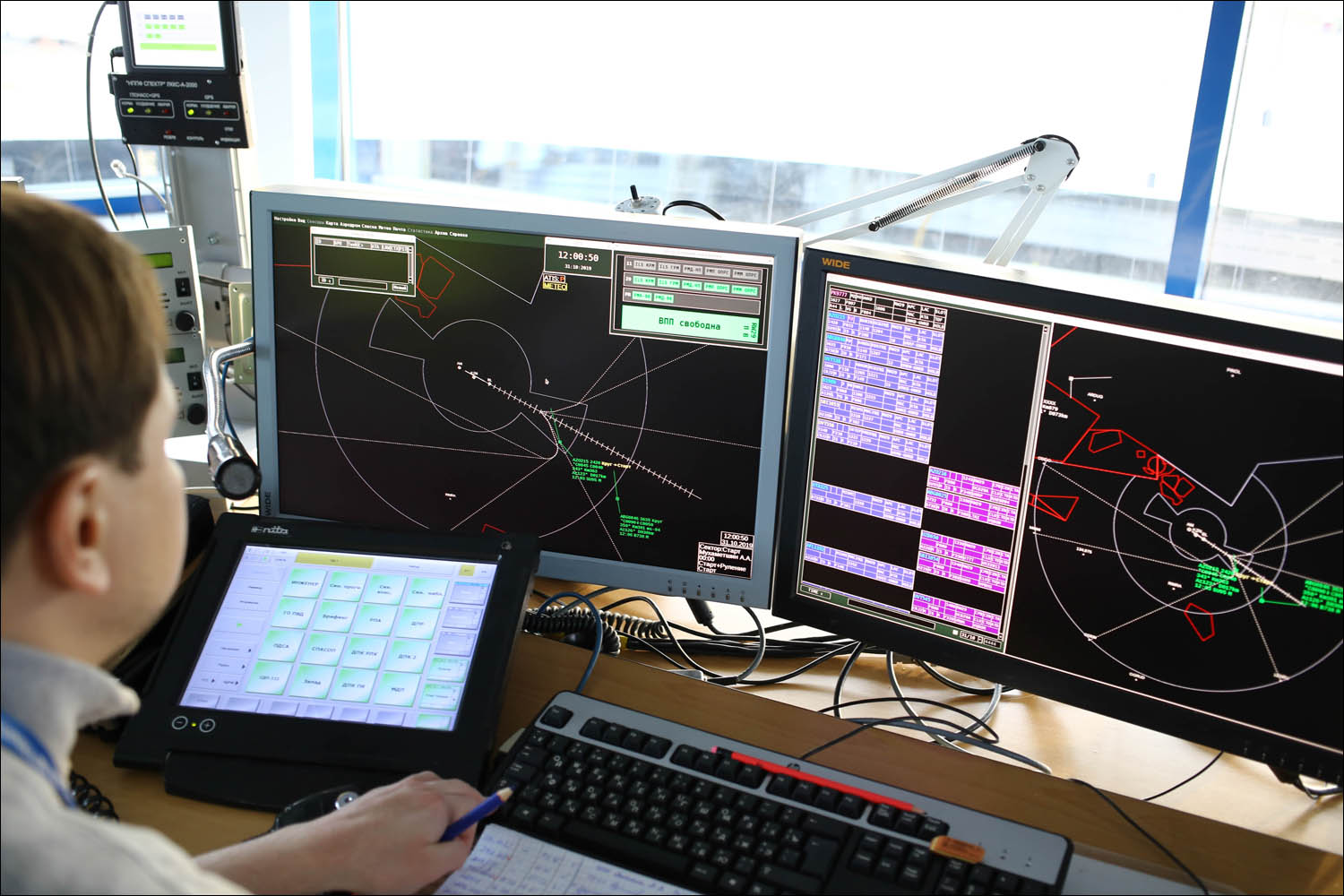
Here is a new multi-position monitoring system: its acceptance tests are still underway. I'd like to see exactly where the plane is at the airport and which one. Again, greatly simplifying: if you cover the airfield with radios, you can listen to the airborne transponder and determine its position. Typically, the defendant does not travel alone without an airplane across the field, so you can very accurately know where the airplane is in real time. This is a very useful story for fogs.
Here you can see the landing plane (the point is exactly in the center):
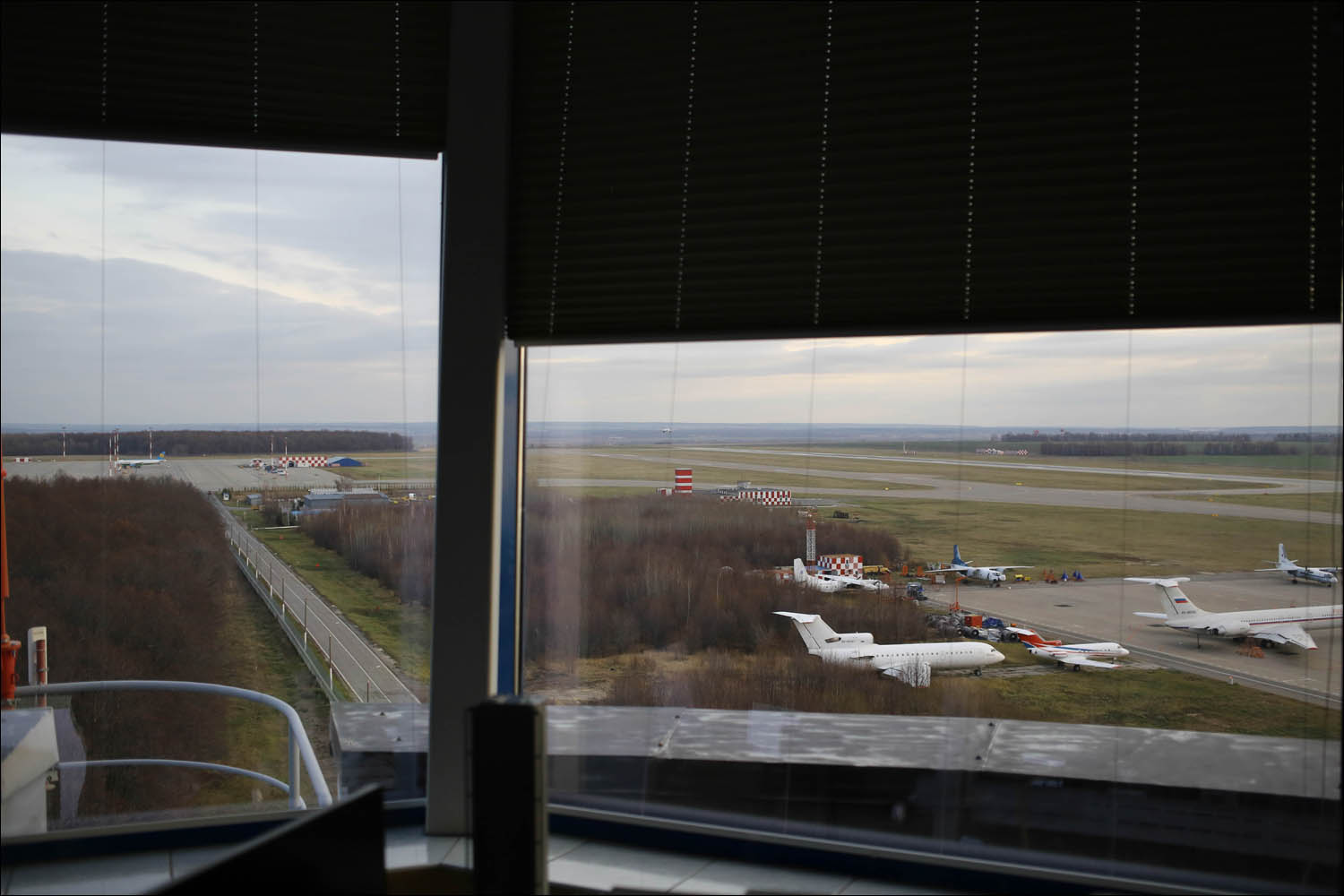
And he is on the screen:
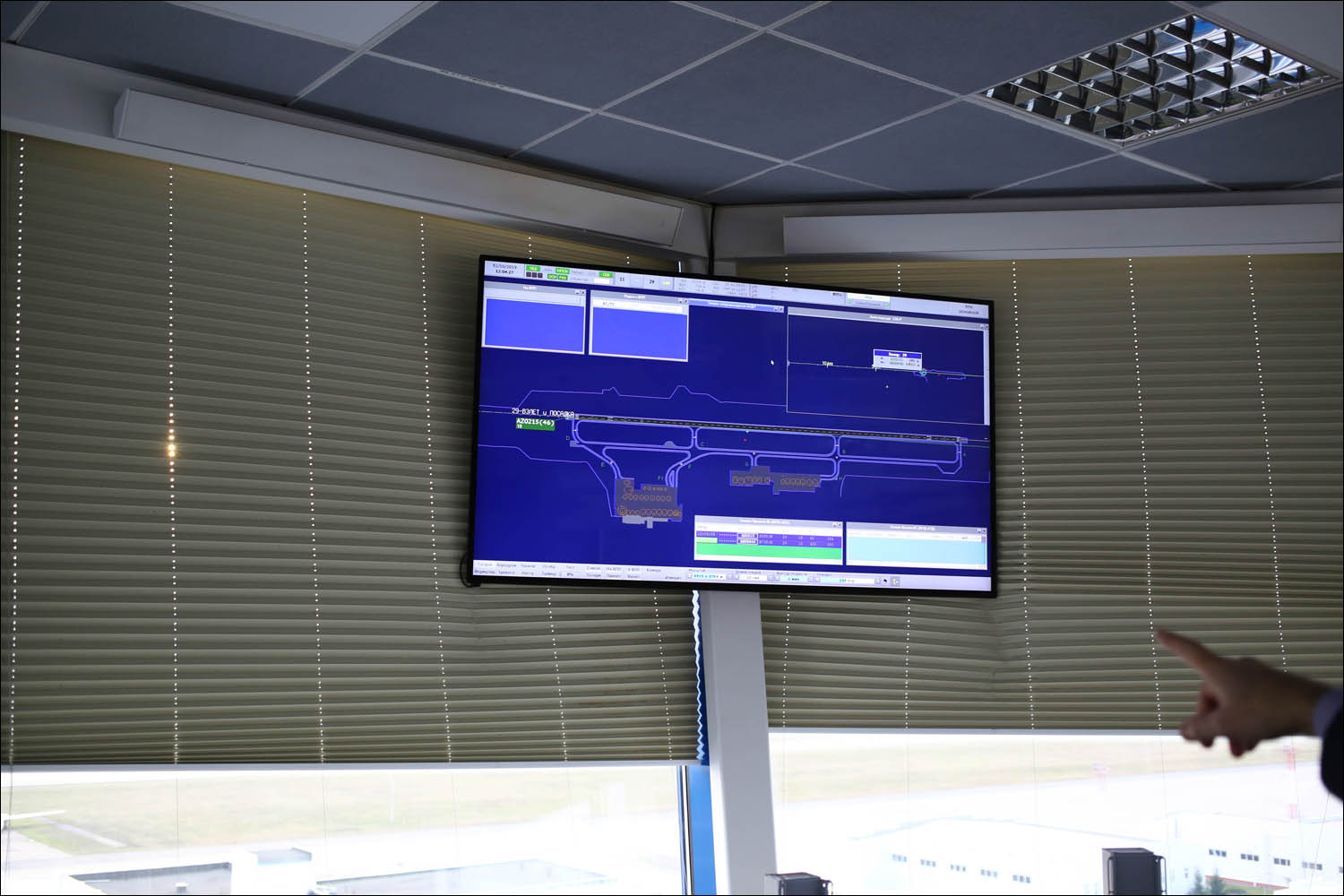
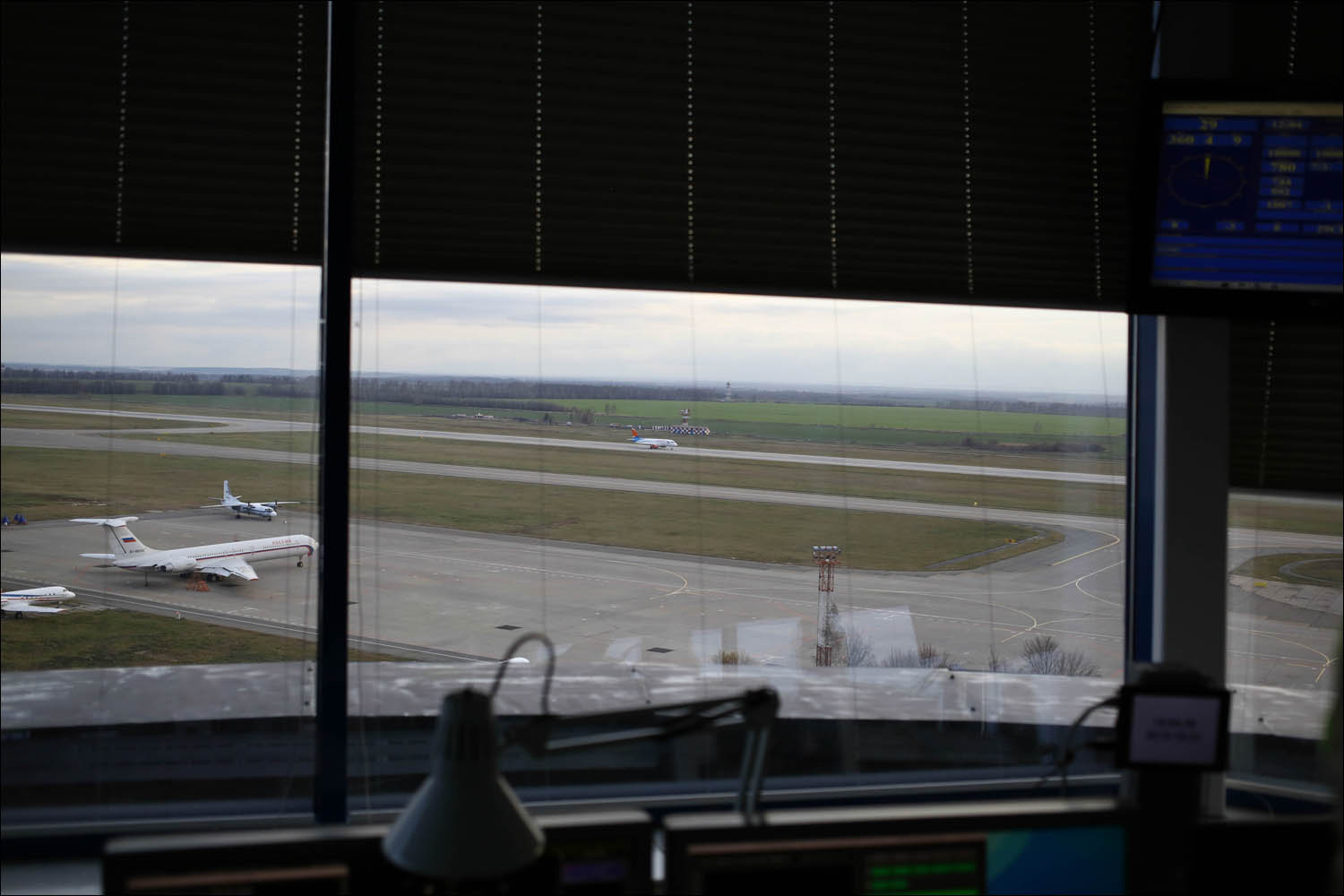
From the tower you can see a lot of interesting things, in particular, the building of the Russian Post for direct processing at the airport.
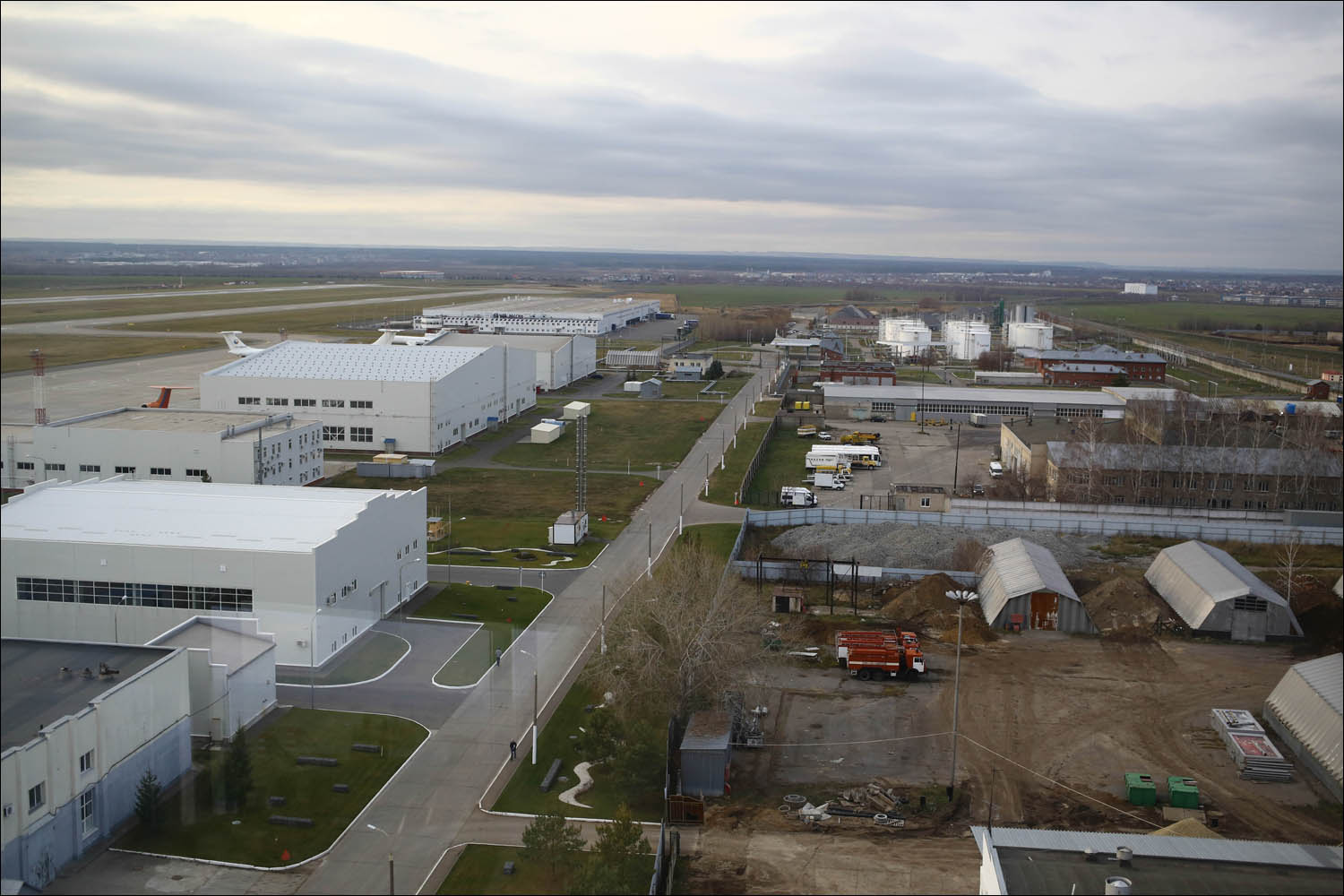 Declared from 36 to 150 thousand parcels per day
Declared from 36 to 150 thousand parcels per dayDirectly below us is an aircraft maintenance base that cannot be photographed. And now we return to the airport itself.
PDSA + airport control center
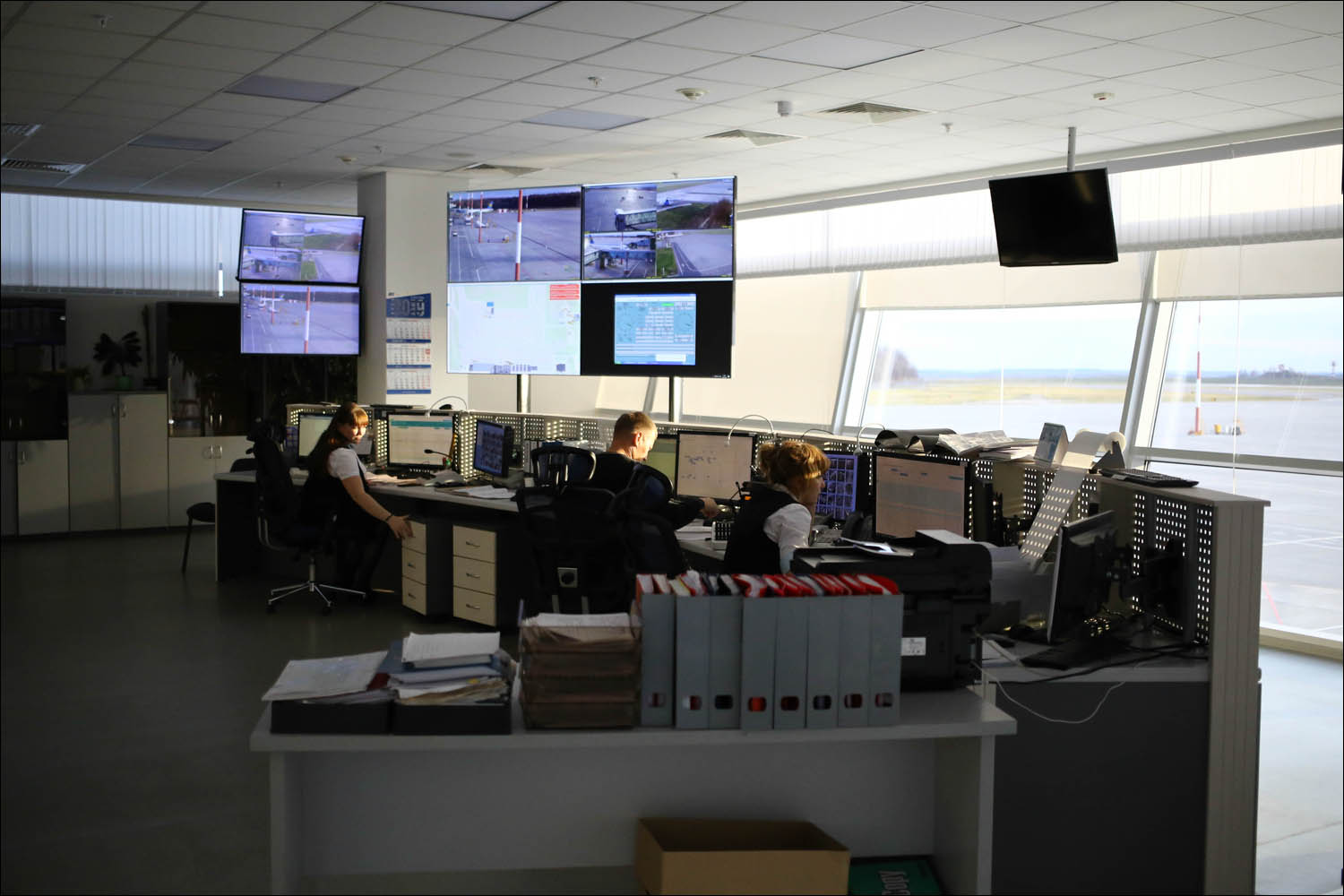
This place is the brain of the airport. Here, all the information is collected from all services and representatives of each of them are sitting. It turns out such a advice from the dispatchers when everyone is thoroughly informed on the specifics of their service, and everyone can quickly make a decision that will take into account all aspects of the airport. This can be compared with a situational center, only a situational center gathers for a crisis situation, and a slightly different commission is included. And here is just a constantly operating team, which has enough knowledge and authority to resolve any issue at the airport.
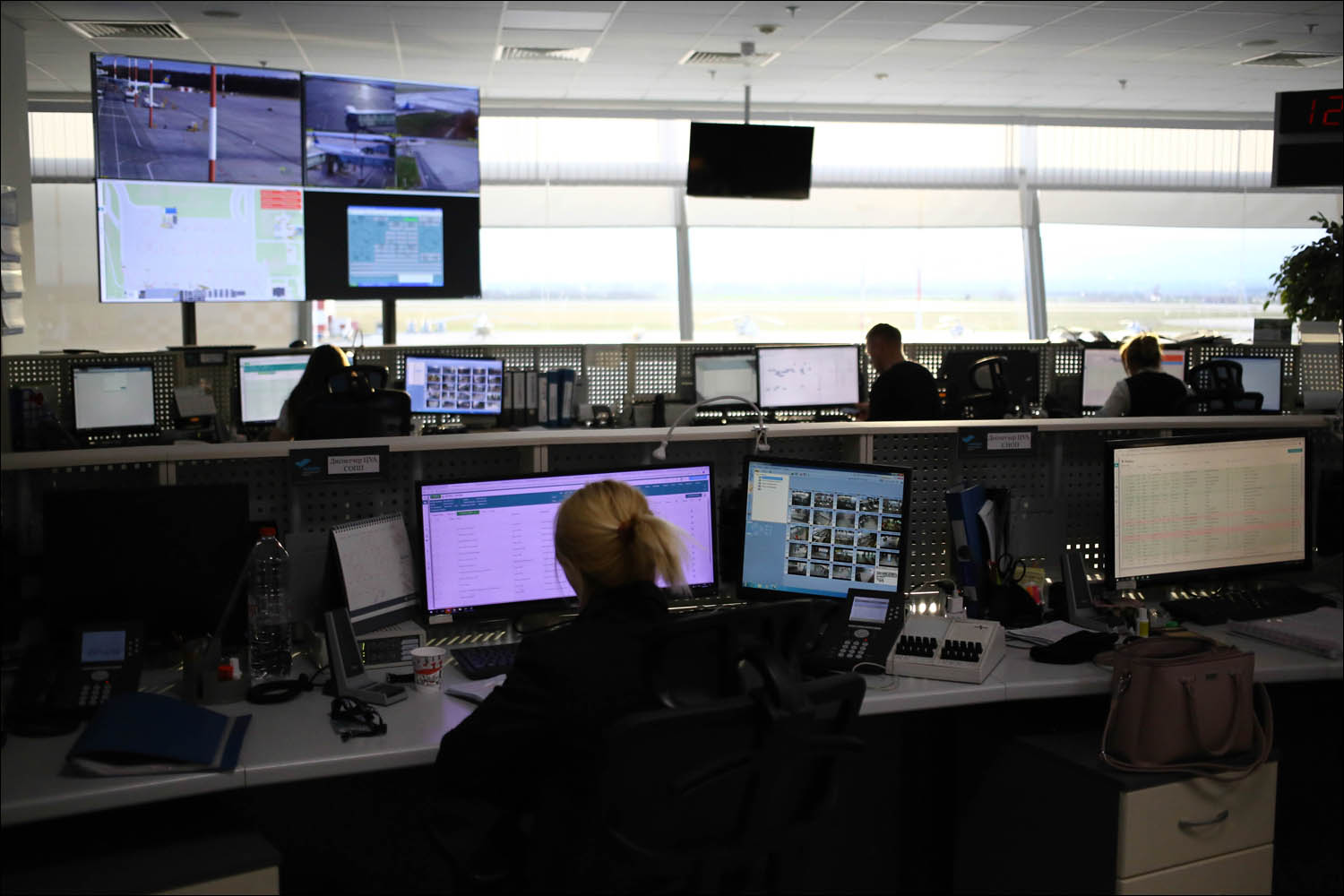 PDSA
PDSA priorities: safety, legal capacity, regularity. That is, first - so that everything goes without stories. Then - so that you can send and receive passengers. And then - so that this is done as cost-effectively as possible.
Weather service
Meteorologists, again, are a separate service, and in the post they are because they are very closely connected with both the ATM and the PDSA.
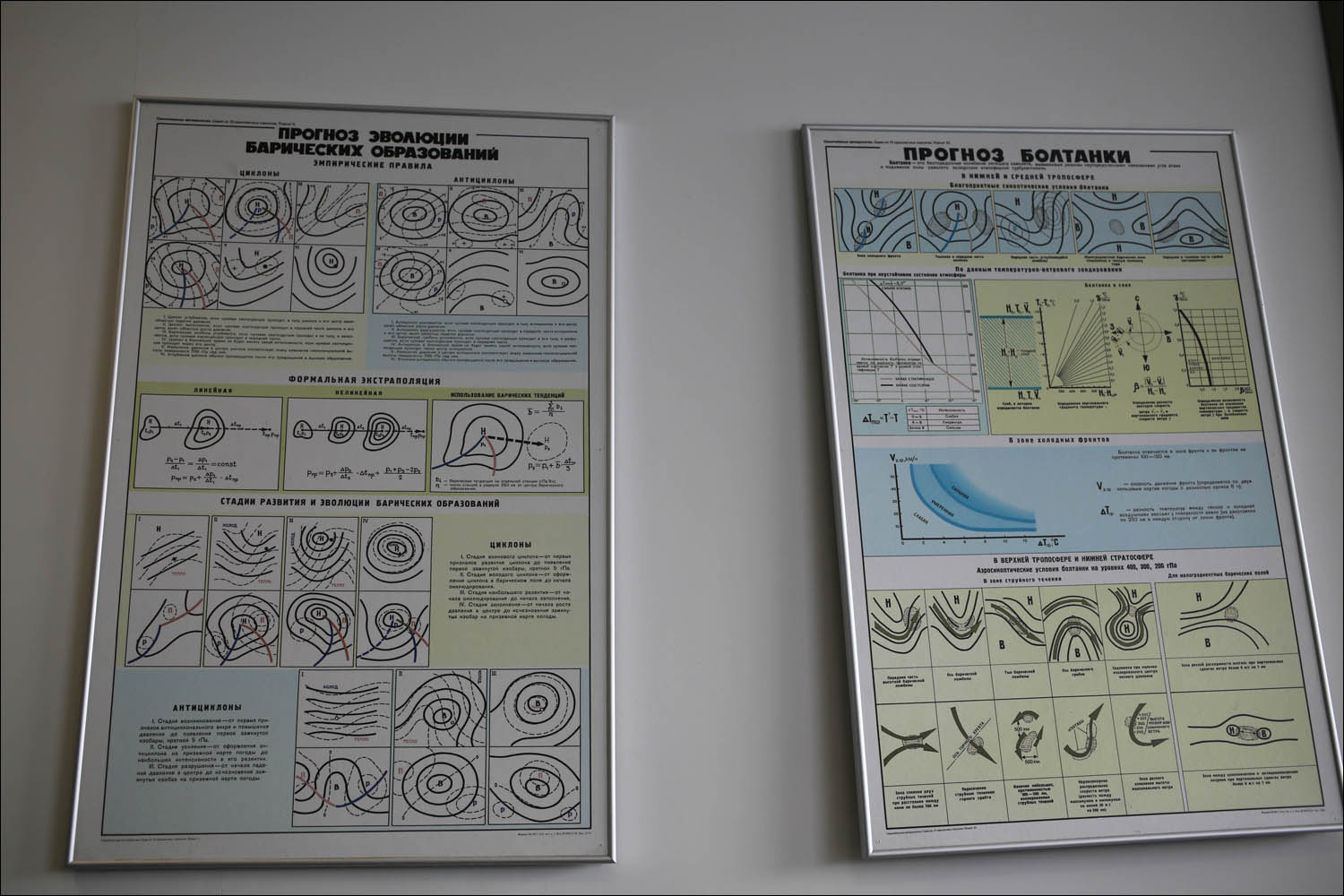
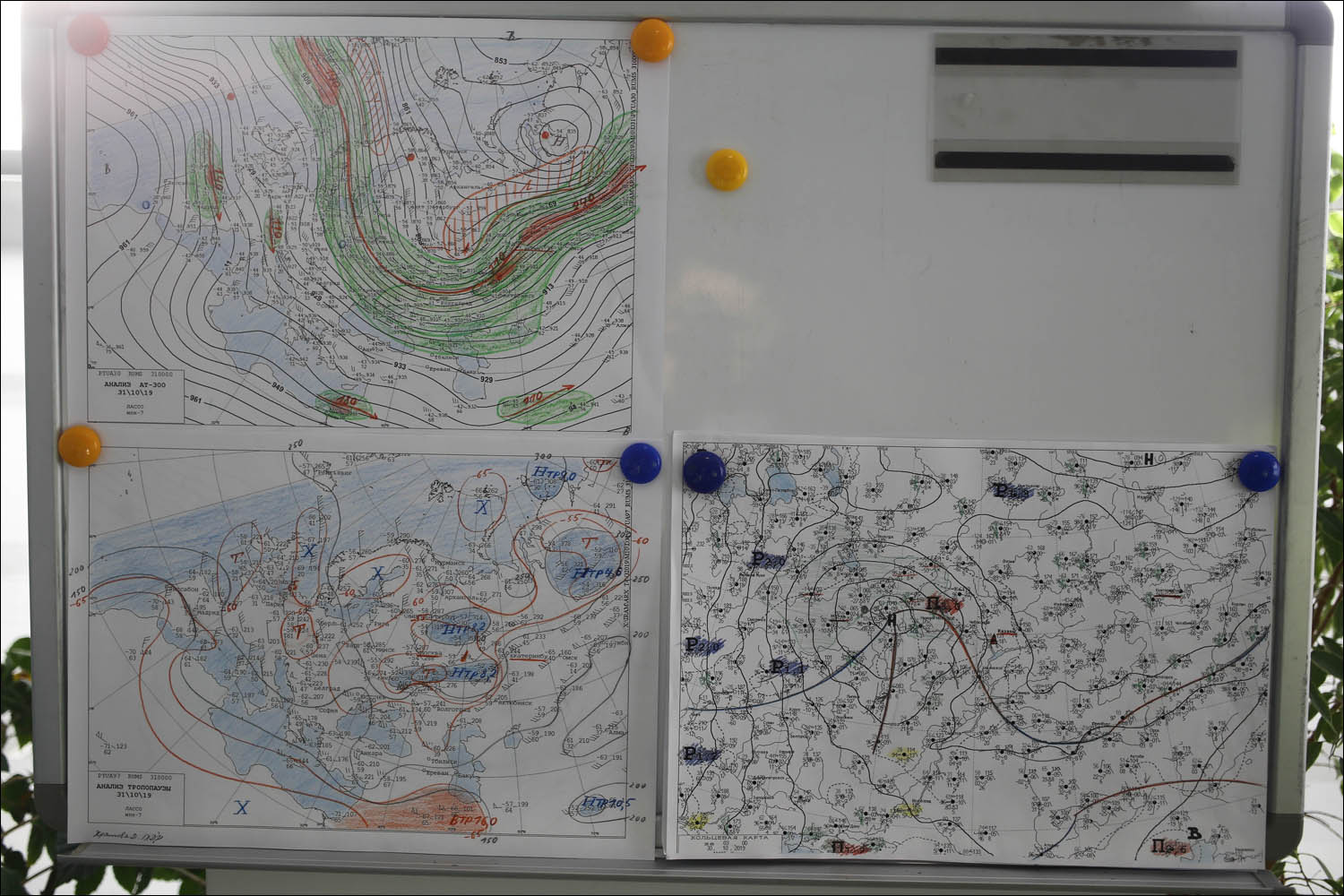
The weather service monitors the current weather (meteorologist technician), makes forecasts for the aerodrome and the area of responsibility of small aviation flights (weather forecaster), advises aircraft crews (weather forecaster-consultant).
The actual weather scoreboard at the airport services and at the workplaces of the air traffic controllers is updated every minute. Telegrams with actual weather data are sent once every 30 minutes (more often in stormy weather). Weather forecasts for the aerodrome and the zone of responsibility of flights of small aircraft, telegrams with actual weather data are sent to the Roshydromet data bank, from where they are received at the request of the crews of ships outside the aerodrome zone.
 Dasha has 3 years of experience as a meteorologist, she graduated from KFU Geofac
Dasha has 3 years of experience as a meteorologist, she graduated from KFU GeofacNear the strip is the
KRAMS complex. These are visibility sensors at the beginning, middle and end of the strip and other standard things for weather stations. There is a backup kit. The wind sensors are installed at two working courses: 291 and 111. That is, the direction of use of the strip (in which direction the plane flies out and lands) is selected not according to the final destination, but according to the current weather. You need to take off against the wind, and you can land in the wind.
All sensors transmit telemetry to the central system. at 14:00 and 2:00 (at lunchtime and at night) a radio probe is released, which shows the distribution of atmospheric parameters at altitude. By analyzing data from a radiosonde, actual weather, meteorological locator data and weather maps, the forecaster does his job.
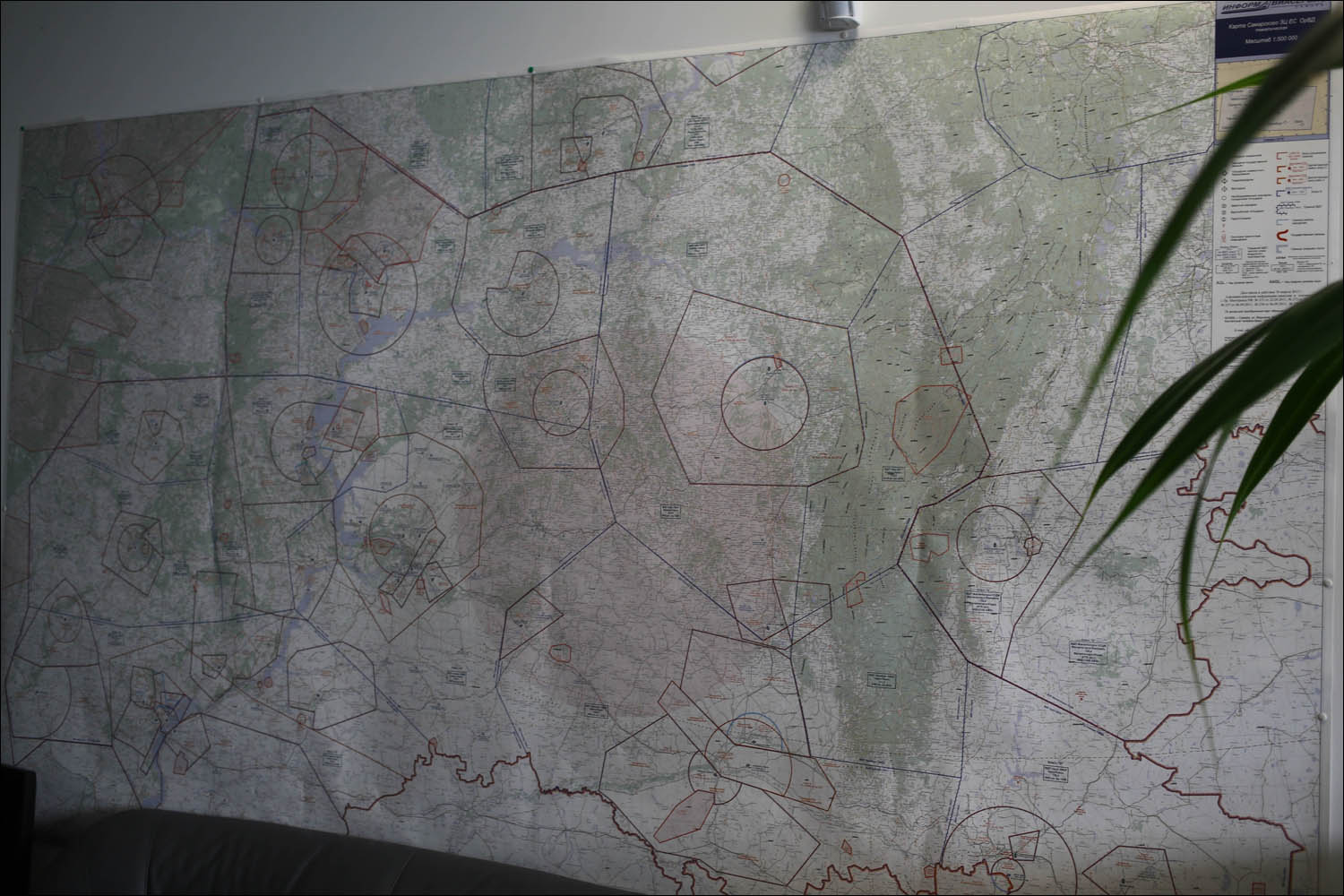
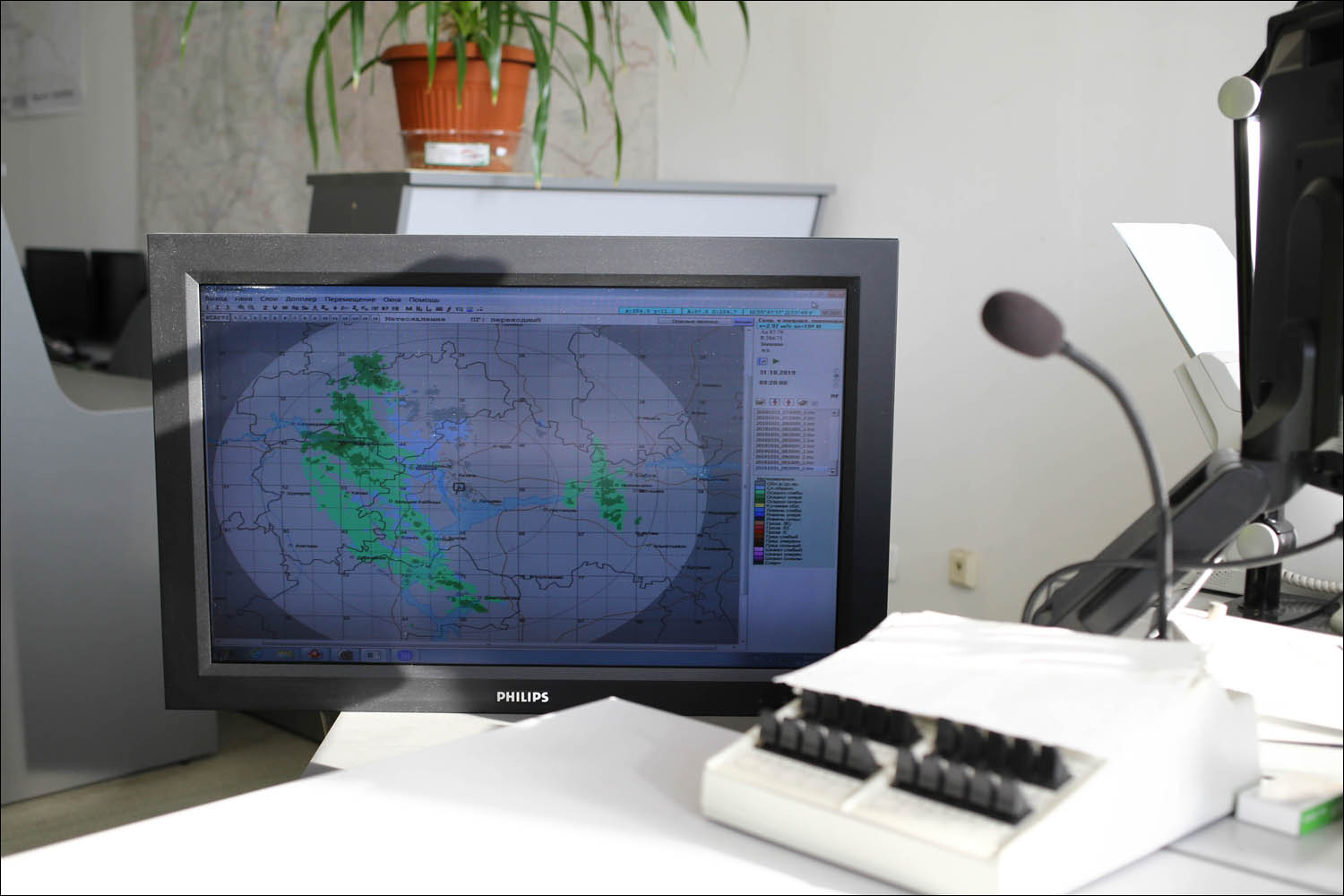
Airport Control Center
If PDSA is the “legislative body”, that is, an information and decision-making management tool, then the airport control center is already the “executive body”, which allocates resources for ground handling, controls all procedures and post-service.
An example of a microtask - if foreigners flew from a warm country directly to us in the snow, then dispatchers think with their heads and try to put such planes on teletraps (though, at least a couple of times they took charters from Thailand at -30 with passengers in shirts and slippers, but they were experienced people, they knew what awaited them on earth and had time to prepare. Thoroughly).
 On the screens above you can see the weather, data from cameras (these are sections, much wider sectors are written and viewed) and the airport map with marks for each piece of equipment on it in real time.
On the screens above you can see the weather, data from cameras (these are sections, much wider sectors are written and viewed) and the airport map with marks for each piece of equipment on it in real time.There is a daily plan for everything, regulations for actions and a standard set of operations. That is, almost every task is covered with instructions on what and how to do. At the junction of competencies, questions arise as to what and how best to do. In what order. For example, is it possible to take responsibility to land passengers if weather forecasters say that it will be possible to clean the strip soon, and the engineer says that after 25 minutes it will be possible to use it. For each decision - a telegram, a journal entry, notification of air traffic control, airline representatives, and so on. Whom to send to depart, whom to hold in the waiting area, whom to immediately send to the spare - all this is also here.
Sources of information - from airport data, data services to regional departments of the Ministry of Internal Affairs and the Ministry of Emergencies, communication with crews.
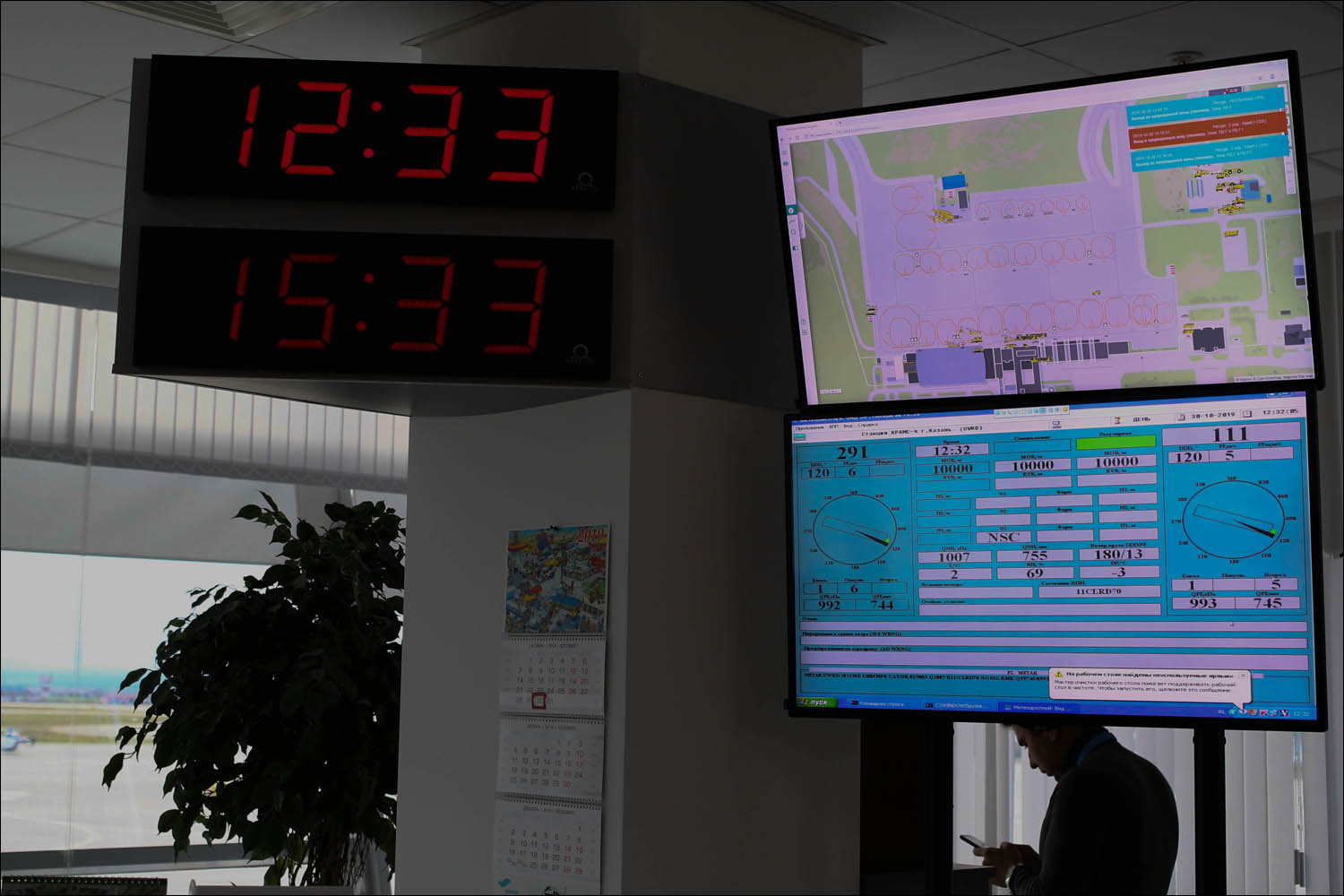 Time - UTC and Kazan (coincides with Moscow time)
Time - UTC and Kazan (coincides with Moscow time)Employees come here mainly from ground handling of passengers, but at the same time having experience in management (not necessarily in a high position, but understanding what work with people is). They must know the structure of the airport, they must pass the selection of law enforcement agencies (an accidental person will not get into such a place). The most important thing is that in a possible emergency situation a person makes a decision. If he is not able to accept it or if he does worse, he will be a ballast in the service.
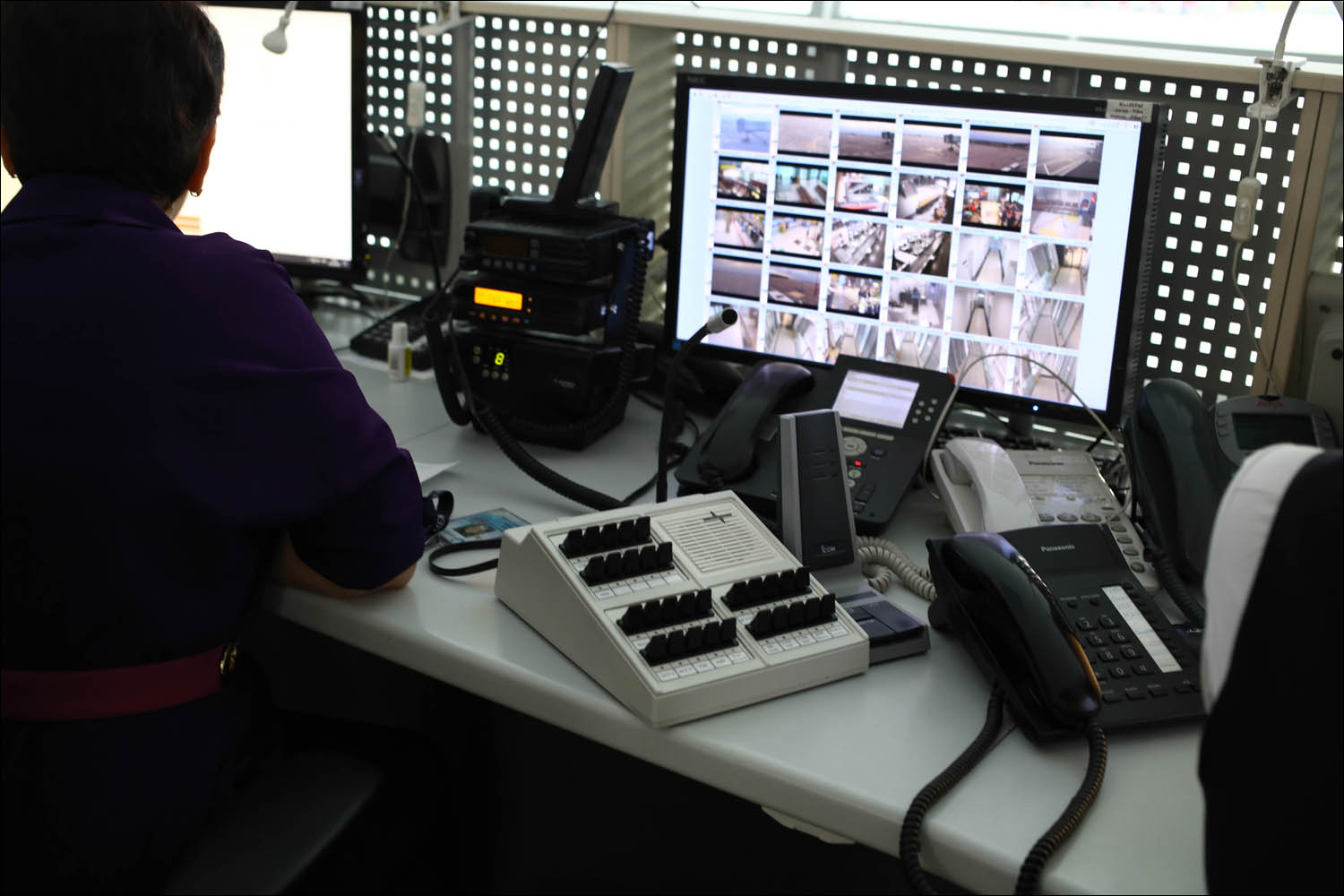
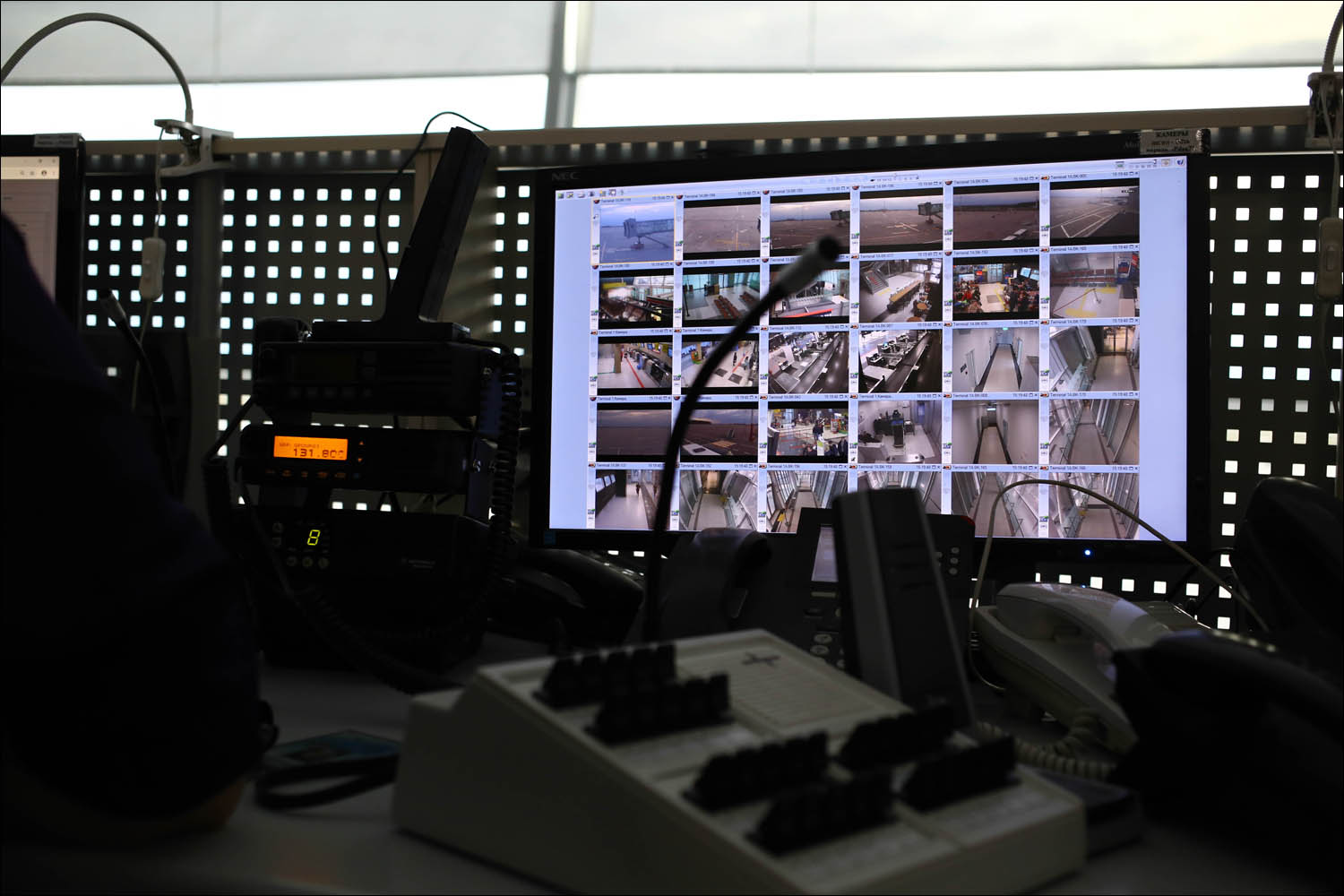
But usually everything is much more prosaic. It is necessary to adjust the work, coordinate all. Quality control cannot be in the unit performing work, therefore PDSA is also responsible for this. Here is the entire investigation of incidents on exits for the technical schedule and chronology of operations. There is an analysis of what happened and determination of measures so that it doesn’t happen that way. Each service reports on problems and solutions, then new processes are created and everything is covered by instructions.
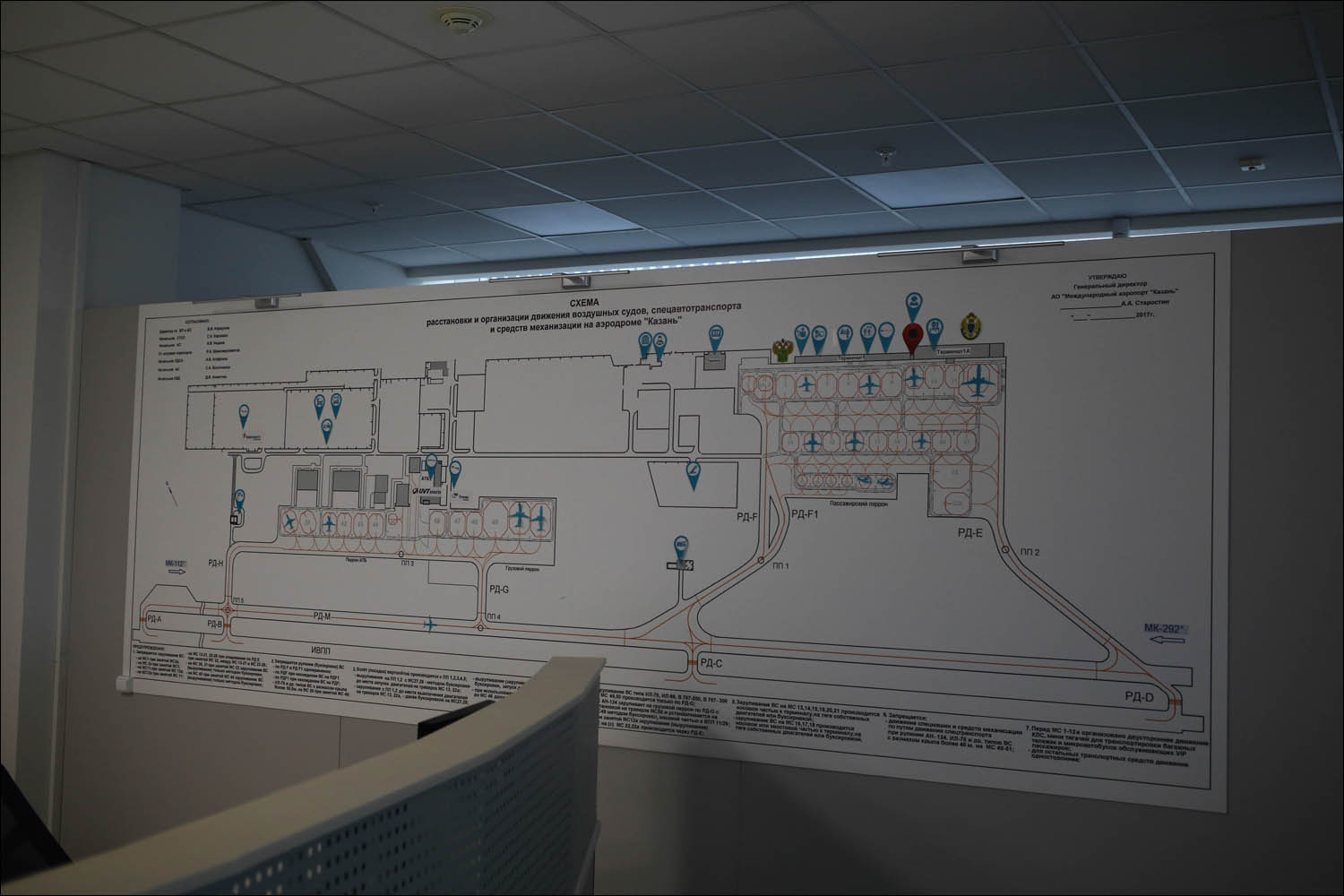

Why else do you need such a "board of controllers"? To make a decision that is beyond the competence of each individual. For example, if you need to solve something that requires large financial costs, it is unlikely that each service individually will be able to. And at the level of senior management in the presence of all opinions of all services - quite quickly.
In general, looking at this center, you can see how cybernetics works. What we call a bus in development is data exchange in the ATM. And what we call service architecture is this control center. The fact is that before each individual dispatcher sat in his service. And if you had to do something, you had to get through to the service, hand it over to the dispatcher, get confirmation from him, then get through to another, tell them that everything was agreed ... And here everything is together, and these long connections are excluded by the “star ". Two years ago, the transition to such a scheme of work began: slowly setting up the center, preparing all the documents, teaching, setting up workplaces. And then they combined services.
In parallel, work was carried out on the IT system “mobile platform”, which shows everything that happens at the airport. There is generally a very interesting story. So, the first idea was to rewrite the system that was used to scan luggage. It was imported, I needed a local developer. We examined a number of Kazan companies (always nearby, they can come and see) and decided to develop their own from scratch. Because there was a difficult choice between ready-made modules and torment with their mutual integration, or immediately writing a normal system. Having estimated the costs both there and there, we chose the second. In general, this is usually the way CRM appears in retail, and that is why there are many different ones. And here came the airport management system.
After scanning the luggage, they wrote a daily plan - who, what, and when should do it in a day. There are services and allies that are based on the territory. Immediately the goal was to integrate with 1C so that you could send an invoice to airlines immediately after sending the flight (30 minutes from take-off). We got all the technical service schedules, divided them according to the criteria (domestic, international), added the turnaround time for parking, the use of telescopic rails and bus delivery. From there, they immediately logically proceeded to the planning of personnel and resources.
They distributed shaitan bricks to all employees on the airfield (phones with truck protection and a large battery, I saw different models, but they were all Android). They have GPS navigation and it is possible to install BT-beacons for indoor navigation (this is in the plans).
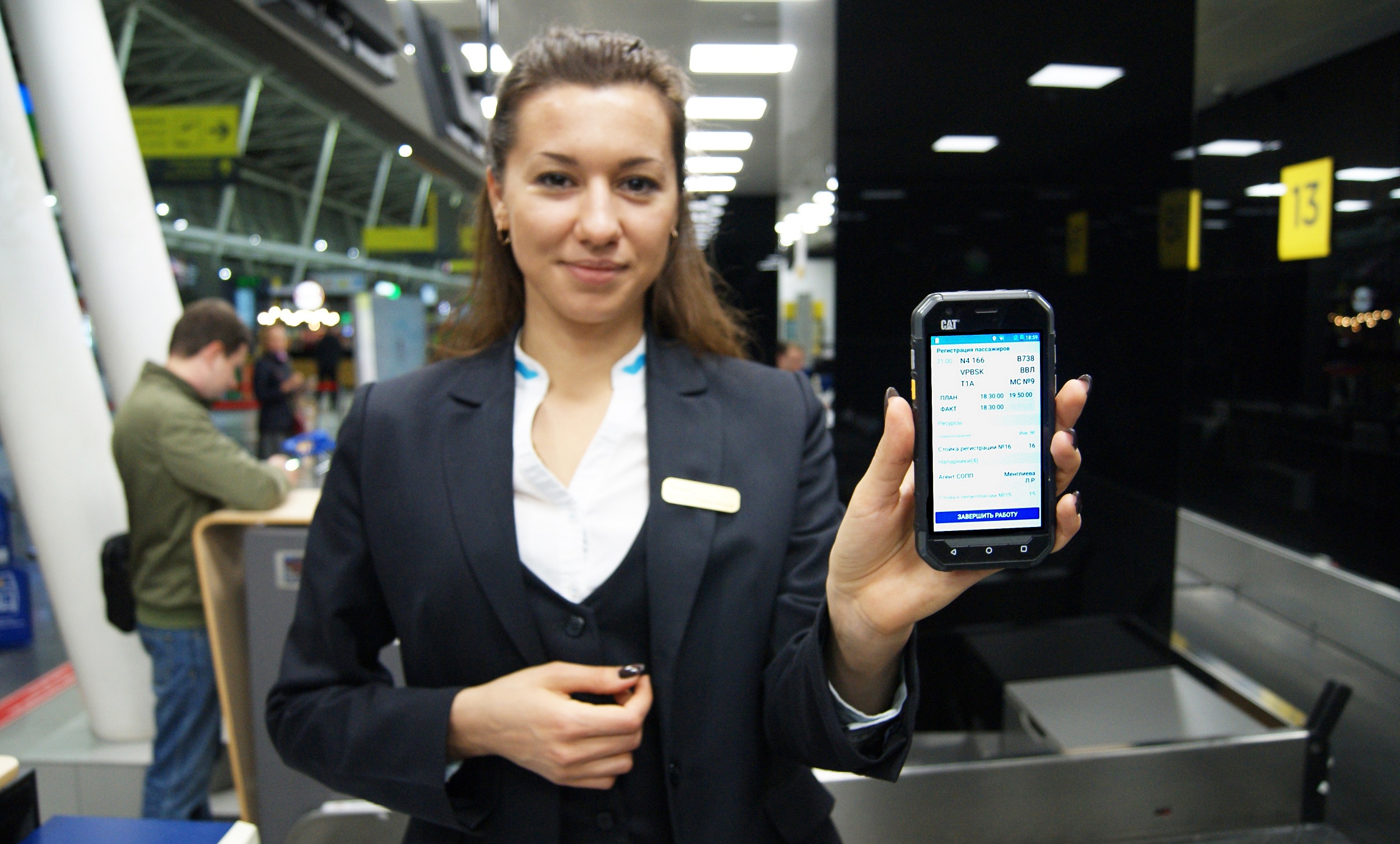 Photos from the archive of the airport, visible piece of iron
Photos from the archive of the airport, visible piece of ironGLONASS-based navigation technology, and it also provides real-time telemetry. As a result, the personnel are visible, the plane is visible, each piece of equipment is visible on the diagram. The entire territory of the platform is covered by official Wi-Fi under the certificate. On mobile devices there is no access to the Internet, only the airport application and access to the local network via air.
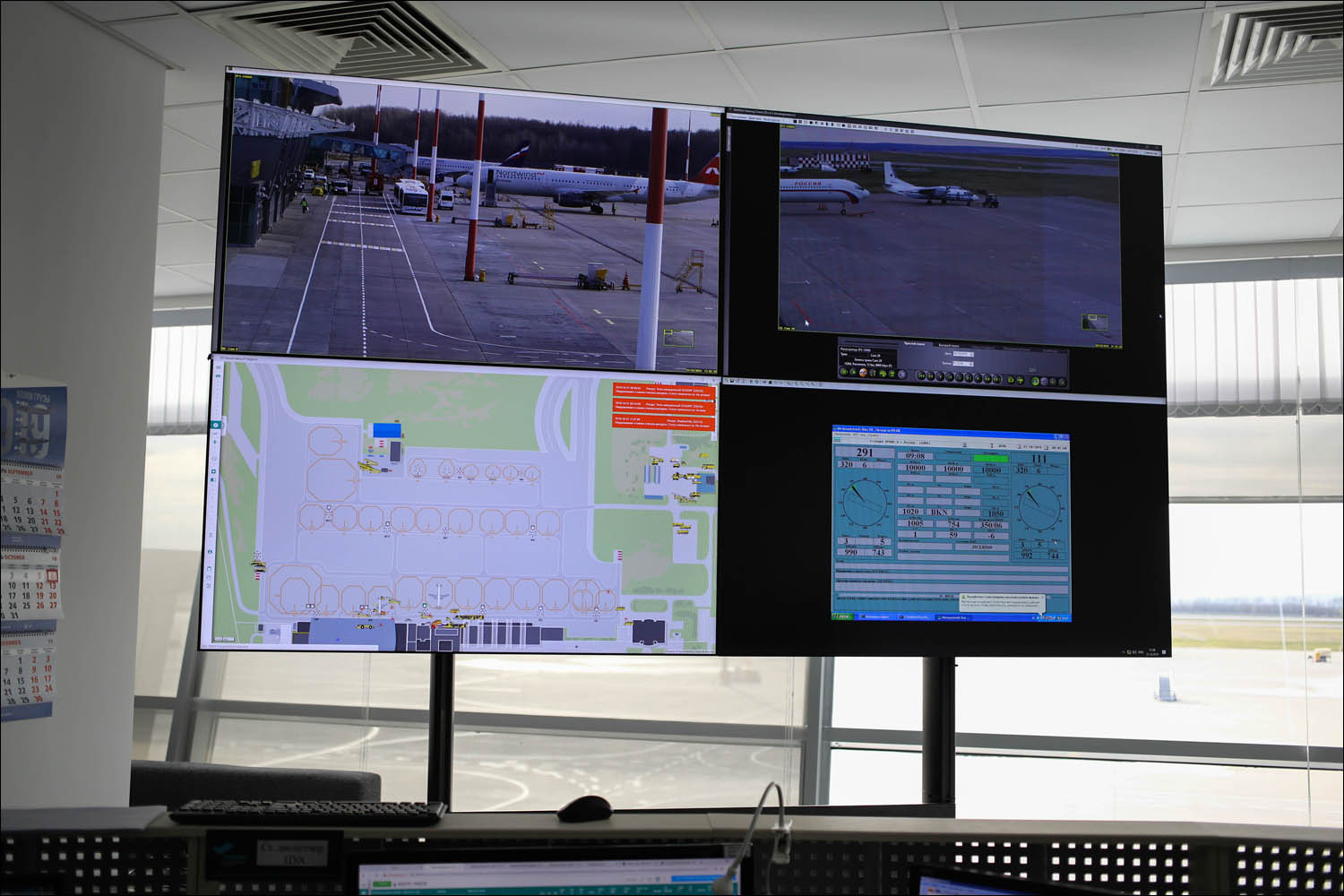
All works are digitized, they are controlled. In case of delay in the beginning or end - there is information on what it affects further. The dispatcher, who is engaged in planning, takes to work.
More IT system updatesThey added the management of information monitors - now there is a direct map of all screens at the airport, and each has a template. Somewhere you can quickly display changes in the schedule, somewhere to reload the screen, and so on. At the same time there is an option to turn off the control from the remote control - so that the audience does not bring their own.
They added a module for a physical examination and a waybill - an employee can’t get a job without this. Plus, in order not to get up twice, ACS is in the same place. And where ACS - there are reports for the leadership, schedules, apron status, tasks of people. As a result, the manager sees the revenue for each flight for any period.
Now a mobile application for passengers works on this base. There is also integration with the parking system. It is planned to finish all this, because in fact the work is only at the very beginning.
Ticketing machines were installed at the airport - any passenger can come up and print a boarding pass using the QR code from the registration. This is often faster and more convenient than going up to the rack - although the next generation of IT systems no longer requires paper.
Finished cabinets for airlines. For example, in S7, representatives can order additional services for a flight, they can confirm the fact of work being done, and set the time for completion. And the analysis of all telegrams with the entry of information into the system. And so there is autocompletion about the movement of the flight and loading the flight, about new flights according to flight plans.
Everything. Now one small example that brings it all together.
How is the plane serviced
- The strip has been cleaned by the engineering service and will be suitable for traction at least until the end of landing. Landing course selected against the wind. There is a technique that is ready to serve the plane.
- ATM controllers bring the plane to the airport. At the same time, the airport knows for a day what parking lot to send the plane to and there will be a bus or teletrap. By the way, some airlines are fundamentally against terapraps (they are more expensive than a bus). The ATM has information about this, so they bring the aircraft on taxiing to the desired parking lot.
- If this is required, the aircraft is met by a follow me machine at the request of the crew. Or marshalling is provided - a man from the ground gestures to pilots what to do.
- Engines turn off. Flashing lights turn off. Pads, cones are installed. Further, ground service officers inspect the aircraft for damage or adhering birds.
- Permission is granted to enter equipment beyond the red line. According to the usual procedure, ladders are suitable on the left, tankers on the right, self-propelled baggage mechanisms and ambulances for the disabled.
- Everyone and everything is unloaded, inspect the trunk.
- Sometimes interior cleaning is done by ground services, sometimes by flight attendants - it depends on the airline.
- Then refueling, flushing toilets, refueling, if necessary - reloading the board.
- Loading passengers.
- If necessary, ice removal and icing protection .
- Then readiness - and departure.
In total, it takes from 35 minutes (low-cost airlines with fast processes) to 2 hours 20 minutes on the ground (large aircraft that need to be refueled for a long time). An average hour.
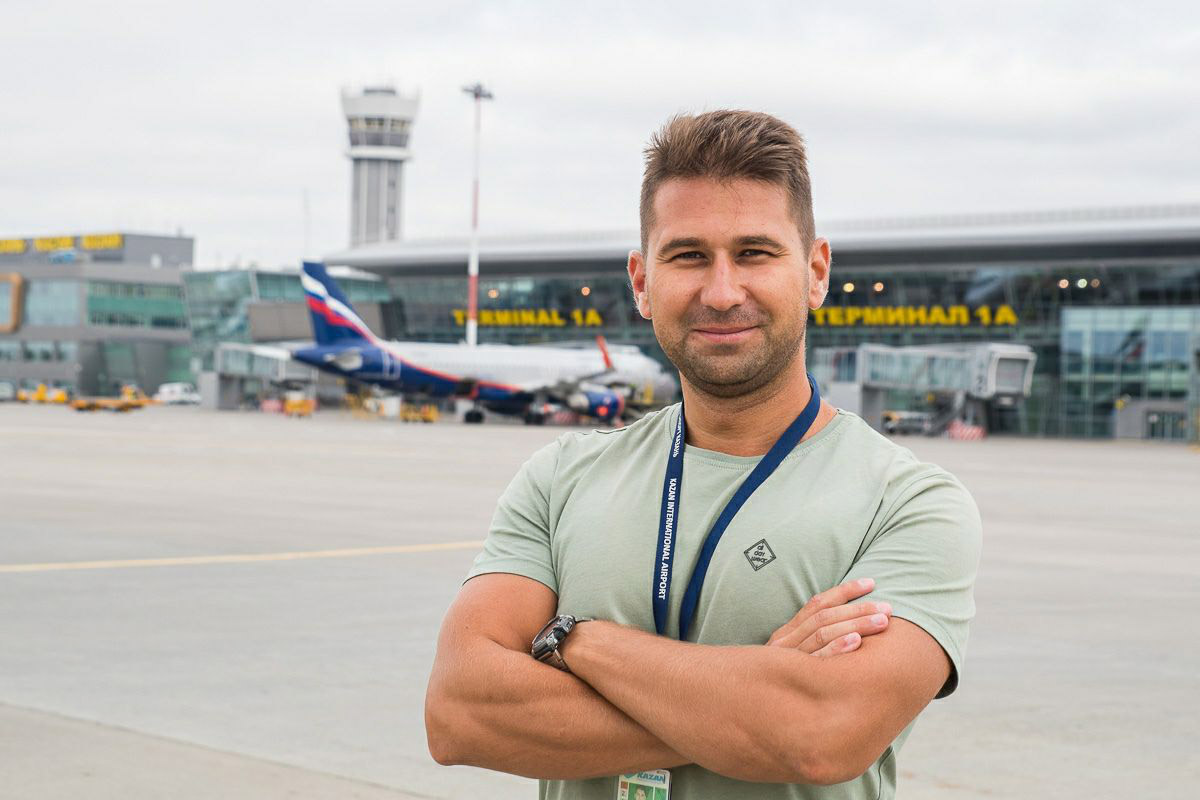 Adel Gataullin and representatives of services were with us at the airport. Photo from the airport archive.
Adel Gataullin and representatives of services were with us at the airport. Photo from the airport archive.The described services lead the aircraft to the terminal. And about the terminal itself, dogs, doctors and passenger service - next time.